Interfaces Volume 2 (2021)
Essays and Reviews in Computing and Culture

Interfaces publishes short essay articles and essay reviews connecting the history of computing/IT studies with contemporary social, cultural, political, economic, or environmental issues. It seeks to be an interface between disciplines, and between academics and broader audiences.
Co-Editors-in-Chief: Jeffrey R. Yost and Amanda Wick
Managing Editor: Melissa J. Dargay
+
2021 (Vol. 2) Table of Contents
Before the Byte, There Was the Word: The Computer Word and Its Many Histories -- J. Rodgers
Early “Frictions” in the Transition towards Cashless Payments -- B. Bátiz-Lazo and T. R. Buckley
Top 10 Signs We Are Talking About IBM’s Corporate Culture -- J. Cortada
NFTs, Digital Scarcity, and the Computational Aura -- A. Vee
Everyday Information Studies: The Case of Deciding Where to Live -- M. Ocepek and W. Aspray
The Cloud, the Civil War, and the “War on Coal” -- P.E. Ceruzzi
Before the Byte, There Was the Word: The Computer Word and Its Many Histories
Johannah Rodgers
Abstract: Tracing and documenting the genealogies of what, in the twentieth century, will become known as “the computer word,” this article explores the importance of the term to the histories and presents of digital computings, the technical and rhetorical functions of verbal language involved with its emergence in the mid-twentieth century U.S., and the import of term’s currency in discourse networks forged across industry, government sponsored university research initiatives, and popular media.
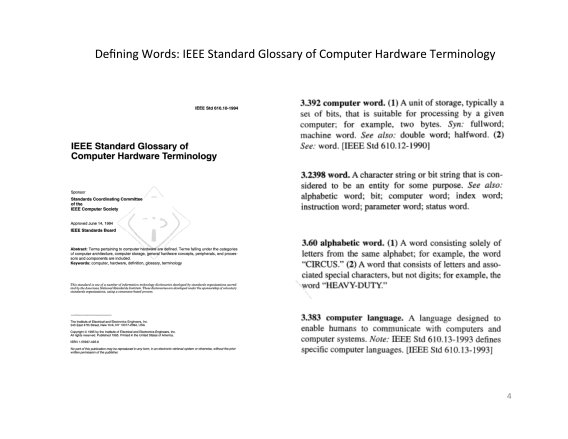
What We Know
Unlike the terms bits and bytes, the computer word, which is defined by the IEEE as "a unit of storage, typically a set of bits, that is suitable for processing by a given computer," (Illustration 1) has not yet become part of popular discourse. Instead the term remains a technical one, familiar to every computer scientist and technician but not to the average consumer. Also unlike the terms bits and bytes, the origins of which have become part of the print record (bits is said to date from a January 9, 1947 Bell Labs memo drafted by John W. Tukey and byte from a June 11, 1956 IBM memo drafted by Werner Bucholz) (Tropp), those surrounding the computer word have not been well documented in either the histories of computings or fields related to it, including writing and media studies. Delving into the histories of computings archive, it is possible to identify a narrow time frame in which the term begins its emergence, sometime between late spring 1945, when John von Neumann drafts his notes that will later be referred to as the "First Draft of the EDVAC Report" and September, 1945, when J. Presper Eckert, John Mauchly, et al., compile their report entitled "Automatic High Speed Computing: A Progress Report on the EDVAC." Yet, the story of the "computer word" is, like many in the histories of computings, neither a classic origin story nor one with a sole author/inventor or single conclusion. Rather, it is collaboratively authored, recursive in its structure, and has implications that, I believe, are only beginning to be fully explored.
Every electronic computational machine since the ENIAC, the first fully electronic computing project in the U.S., has been described as having a "word size" and as containing a certain number of “words.” Acting as an interface between hardware and what will later become known as software, the computer word becomes one of the building blocks for machine and programming languages. It is one part of the process that enables hardware and the instructions controlling it to communicate and "understand" one another. Technically, choosing a computer word's "word size" is one of the earliest steps in chip design and, metaphorically, the computer word can be said to function as a word does in "telementational models" (Harris) of human to human communication: it allows for information to be transmitted and exchanged according to a "standard" meaning. While, in human communication, verbal words, i.e., those spoken or inscribed by humans, rarely maintain a fixed meaning, in machine communication, the computer word and the bytes and bits that will later be said to compose it have been, over time, made to adhere to such standards. Figuratively, if bits can be said to be the millimeters of digital electronic computers and bytes the centimeters, the computer word can be said to function as the meter.

Despite the technical significance of the computer word to the historic and current functions of digital electronic computers, documenting its histories is, for several reasons, anything but straightforward, in part because of the complexities of the EDVAC project itself, in part because of the later depictions of the EDVAC project in relation to projects predating it, and in part because of issues related to the histories of computings archives. Unlike the ENIAC, the EDVAC project unfolded during a time of transition from war-time to post-war based funding priorities for the U.S. military and from university-focused to industry-focused research and development initiatives. As a result, it is one that continues to provide scholars with a wealth of material and issues (technical, economic, political, and socio-cultural) to consider in relation to other electronic and electro-mechanical computing projects in the United States. The EDVAC project was, as Michael Williams has clearly documented, a fraught one and produced a machine that may actually have only been operational for a very short time and differed considerably from initial design documents. Further, recent research related to the ENIAC project by Haigh, Priestley and others, has emphasized the similarities rather than the differences between the ENIAC and EDVAC projects and called into question the portrayal of the "Von Neumann" architecture as the invention of von Neumann or a clear departure from the architectures of earlier "computing" projects in the U.S.
The availability, accessibility, and reliability of documentary archival materials also all play roles in how the (hi)stories of the computer word can be told. Just to point to two selected examples related to my research for this project, the digital copy of Eckert and Mauchly's "Automatic High Speed Computing" report available in the archive of the Museum of the History of Computing is an excerpt of the complete report. While this particular copy is valuable to researchers since it is from the archive of Donald Knuth and contains his notes, at present, no complete digital copy of the report exists that is publicly accessible. It was, in fact, only through the very generous support and assistance of the University of Pennsylvania Libraries Special Collections that I was able to remotely access a digitized copy. The existence of as yet uncatalogued materials raises other issues unique to the histories of computings archives. As a result of his ongoing research involving the Goldstine papers at the American Philosophical Association archive, Mark Priestly has drawn attention to manuscripts and unpublished lecture notes with significant implications for how not only specific terms, including the computer word, are interpreted but to other topics, such as how Turing's work may have been used by von Neumann.

While the paper trail documenting this term "computer word" will be for some time still unfolding, what we do have currently are paper traces documenting its evolution from a term with several different functions as a rhetorical device to a technical term and finally to a technical standard. The September, 1945 "Progress Report on the EDVAC" appears to be the first time that the term “word” is used in an official document and proposal. Attributed to von Neumann in a footnote (Illustration 3), the term "word" (without quotation marks!) is introduced in a manner with more than slight Biblical overtones: "each pulse pattern representing a number or an order will be called a word*" (Eckert, et al.) In the earlier, June, 1945 Draft EDVAC report, von Neumann refers to the unit that will later be referred to as a “word” as a “code word," a term that references the operations of telegraphic machines (Priestley) and also likely the “codes” contained on the punched cards used to feed program instructions to early automatic calculators, including the ENIAC and the Mark I. Although there are references to a/the "word," "words," and specific types of "words," i.e., logical words, machine words, instruction words, control words, in documents throughout the 1950s, the earliest mention of the term "computer word" in all likelihood appears later, around 1960 (Stibitz, COBOL Report).
What We Are Still Learning
These findings reveal some useful insights into both what we know and to what we are still in the process of learning about the histories of computings and the roles of verbal language, linguistics, and language education in them.
As Nofre, et al., emphasize in their 2014 article "When Technology Became Language," the mid-1940s represent an important inflection point in how electronic digital computers are being conceived and discussed as "understanding" and engaging with language. The introduction of the term "word" to describe the operations of the EDVAC architecture appears to be one part of the discursive and technical transformation of high speed automatic calculators to general purpose digital electronic computers and to language processing (if not yet language possessing) machines. One of the key differences between the ENIAC and the EDVAC was the addition of new types of electronic storage media and its use for not only storing but manipulating codes “internally” to instruct the machine (Burks). One part of the external memory in the ENIAC, as Eckert explains it in his first Moore lecture, was “the human brain” (116). The ENIAC was a decimal-based calculator and required significant input from skilled human operators in order to function. Both issues are noteworthy because part of the story of this metaphor of the word has to do with its emergence at the same time that there is a moving away from human to machine readable writing systems (decimal to binary) and communication and storage media (wires to pulses; cards, paper, and human brains to short and long tanks and mercury delay lines). In a Turing complete machine, the machine must have some way of representing its own operations; both the ENIAC and the EDVAC had this capability. However, one major difference between these two machines was the manner in which instructions were represented and communicated so the machine could “understand” them. With the ENIAC, wires were used as the system of notation; with the EDVAC, the alphabet became another system of notation (Alt).
These paper traces from the 1940s also underscore the collaborative environment in which military funded research projects were being developed and documented in the U.S. While I am not suggesting with this term "collaborative" that in such an environment everyone was acting communally or even getting along while they worked together, I am arguing that fluidity and responsive improvisation are evident both in the discourse and the technical systems being described. What this means to documenting the genealogy of the computer word is that if the neologism is to be attributed to von Neumann, it would be necessary to put quotation marks around the terms "computer word" and "von Neumann" to indicate that both are names applied retroactively to fix the meanings of phenomena that were still emergent when placed in their specific historical contexts. Neither the "computer word" nor what is now still frequently referred to as the "Von Neumann Architecture" emerges fully formed as a concept or technical standard in 1945 when von Neumann drafted his notes for the EDVAC project in Los Alamos, New Mexico, referred to the unit that will be used to communicate data and instructions in the EDVAC project as a "code word," and handed his notes to one or more secretaries to type up and possibly reproduce and circulate (Williams).
The absence of a single author or origin story for terms like the computer word reinforces the importance of analyzing the rhetorical contexts in which the word choices of von Neumann/"von Neumann" and others are made, as well as the processes of exchange and circulation of these terms (Nofre, Martin). Paul Ceruzzi's recent article in this journal about the myths of immateriality surrounding the natural resource intensive reality of "cloud"-based computing is one example of the power of names to shape discourse and its receptions (Ceruzzi). Another example relates to the complexities involved in attempts by Tropp to depict the emergence of the term "bit" as a story with a single author. As the multilayered documentation presented in Tropp's article makes clear, there were many contributors to the creation of the neologism bit, which become metaphorically and technically imbricated in human discourse and the engineering projects they inform and describe. The term "bit," which was originally named an "alternative" by Shannon, was deemed at one point a "bigit," and, while, Tukey's memo may have been the first document we currently have access to in which the term appears, even a cursory reading of it reveals that drawing from it the conclusion that Tukey "coined" the term is far from certain (Tropp).
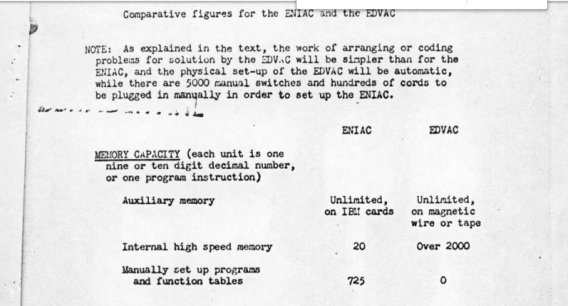
What's In a Word?: Teaching Machines to Read and Write
After 1946, the "signifying operations" (Rodgers) of terms related to and involving language as applied to digital electronic computers continue to widen in the technical, industrial, and popular literature (Nofre, Martin). Part of my interest in this relates to the fact that what we now call the early history of digital electronic computing, calculating machines are constructed based on models of the human, which are then explained via metaphors to influence decisions being made regarding the funding of educational and work initiatives for human computers and electronic computers based on the costs and interchangeability of the two (Grier). As Grace Hopper will point out in her 1952 article "The Education of a Computer," the EDVAC architecture is identical to a schematized cognitive model of a writing/calculating subject. In this context, the date and location of the drafting of the EDVAC Notes and later report are both significant considering their purpose and later reception, as are the later technical decisions that placed the affordances and performance standards of machinic operability over those of human legibility in the EDVAC project (Illustration 4). Yet, it is in part through verbal logic and the deployment of rhetoric that decisions were made regarding whose and what logics and languages would become "hard wired" into digital electronic computing machines.
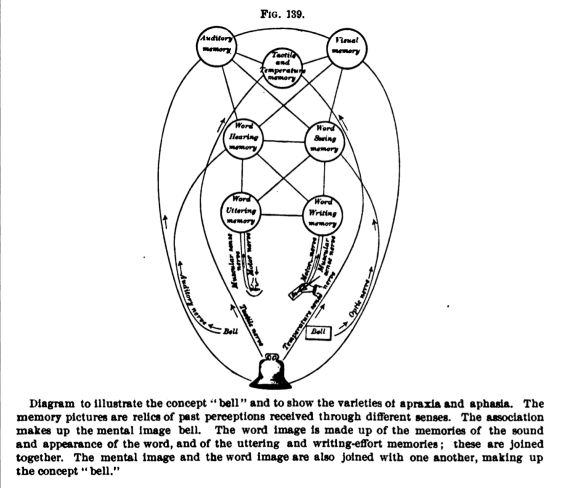
Somewhat ironically, though, perhaps, inevitably, it is with issues of representation and the roles of spoken and inscribed language in depicting and constructing realities and histories that the intrigue involved with interpreting relationships between alphabetic words and computer words really begins. While it is impossible to know the exact reasons for a specific word choice, it is possible to consider the rhetorical contexts in which the EDVAC report was written. The term "word" functioned both to signal what was new about the project while also performing some explanatory work to an audience deciding the fate of the EDVAC funding proposals. Yet the target domain of this metaphor is human language processing, which it is presumed, rather than proved, that the proposed technical system will replicate (Harris). In giving the EDVAC calculating machine the ability to "instruct" itself with the metaphor of the word, binary arithmetic calculation is paired with alphabetic communication in a way that has implications for the processes involved with both and based on assumptions about how language functions, what the purposes of communication are, and for the benefit of specific parties and interests (Dick). From a writing studies perspective, the word choice of the "code word" and "word" connect the mid-1940s with the instrumentalization of writing and human writing subjects that had been occurring throughout the late nineteenth and early twentieth centuries (Gitelman, Rodgers) and to early discussions of "AI" and the roles and histories of writing, logic, and language education policies embedded in them (Kay, De Mol, Heyck).
Acknowledgments
I am grateful to Joseph Tabbi, Cara Murray, and Robert Landon for their comments and suggestions related to earlier drafts of this article. Thank you also to Jeffrey Yost for his insightful suggestions, and to Amanda Wick and Melissa Dargay for their work and contributions. Holly Mengel, and David Azzolina for their assistance in remotely accessing a digital copy of "Automatic High Speed Computing: A Progress Report on the EDVAC," and to Donald Breckenridge for his practical, editorial, and emotional support. Finally, a special thanks to John H. Pollack, Curator, Kislak Center for Special Collections, Rare Books and Manuscripts at the University of Pennsylvania Libraries, and his colleagues Charles Cobine, Eric Dillalogue.
Bibliography
Alt, Franz. (July 1972). "Archaeology of Computers: Reminiscences, 1945-1947." Communications of the ACM, vol. 15, no. 7, pp. 693–694. https://doi.org/10.1145/361454.361528.
Burks, Arthur W. (1978). "From ENIAC to the Stored-Program Computer: Two Revolutions in Computers." Logic of Computers Group, Technical Report No. 210. https://deepblue.lib.umich.edu/handle/2027.42/3961.
Burks, Arthur W., Herman H. Goldstine, and John von Neumann. (28 June 1946). Preliminary Discussion of the Logical Design of an Electronic Computer Instrument. Institute for Advanced Study. https://library.ias.edu/files/Prelim_Disc_Logical_Design.pdf
Campbell-Kelly, M. and Williams, M. R., eds. (1985). The Moore School Lectures: Theory and Techniques for Design of Electronic Digital Computers, volume 9 of Charles Babbage Institute Reprint Series for the History of Computing. MIT P. https://archive.org/details/mooreschoollectu0000unse.
Ceruzzi, Paul E. (2021). "The Cloud, the Civil War, and the 'War on Coal.' Interfaces: Essays and Reviews in Computing and Culture, Charles Babbage Institute, University of Minnesota. https://cse.umn.edu/cbi/interfaces.
De Mol, Liesbeth and Giuseppe Primiero. (2015). "When Logic Meets Engineering:
Introduction to Logical Issues in the History and Philosophy of Computer Science." History and Philosophy of Logic, vol. 36, no. 3, pp. 195-204. https://doi.org/10.1080/01445340.2015.1084183.
Dick, Stephanie. (April–June 2013). "Machines Who Write." IEEE Annals of the History of Computing, Vol. 35, No. 2, pp. 88-87. https://doi.org/10.1109/MAHC.2013.21.
Eckert, J. P. (1985). "A Preview of a Digital Computing Machine." The Moore School Lectures: Theory and Techniques for Design of Electronic Digital Computers, volume 9 of Charles Babbage Institute Reprint Series for the History of Computing, edited by M. Campbell-Kelly and M.R. Williams, MIT P. https://archive.org/details/mooreschoollectu0000unsepp. 109-128.
Eckert, J. P. and Mauchly, J. W. (September 30, 1945). Automatic High Speed Computing: A Progress Report on the EDVAC, Moore School of Electrical Engineering, University of Pennsylvania.
Gitelman, Lisa. (1999). Scripts, Grooves, and Writing Machines: Representing Technology in the Edison Era. Stanford UP.
Heyck, Hunter. (2014). “The Organizational Revolution and the Human Sciences.” Isis, vol. 105, no. 1, pp. 1–31. https://www.journals.uchicago.edu/doi/10.1086/675549.
Harris, Roy. (1987). The Language Machine. Duckworth.
Haigh, Thomas, Mark Priestley, and Crispin Rope. (January-March 2014). "Reconsidering the Stored-Program Concept." IEEE Annals of the History of Computing, vol. 36, no. 1, pp. 40-75. https://doi.org/10.1109/MAHC.2013.56.
Haigh, Thomas and Mark Priestley. (January 2020). "Von Neumann Thought Turing's Universal Machine was 'Simple and Neat.': But That Didn't Tell Him How to Design a Computer." Communications of the ACM, vol. 63, no. 1, pp. 26-32. https://doi.org/10.1145/3372920.
Hopper, Grace M. “The Education of a Computer.” (1952). Proceedings of the 1952 ACM National Meeting (Pittsburgh), edited by ACM and C. V. L. Smith. ACM Press, pp. 243–49.
IEEE Standards Board. (1995). IEEE Standard Glossary of Computer Hardware Terminology. IEEE. doi: 10.1109/IEEESTD.1995.79522.
Kay, Lily. (2001). "From Logical Neurons to Poetic Embodiments of Mind: Warren S. McCulloch's Project in Neuroscience." Science in Context vol. 14, no. 4, pp. 591-614.
Martin, C. Dianne. (April 1994). "The Myth of the Awesome Thinking Machine." Communications of the ACM, vol. 36, no.4, pp: 120-33.
Nofre, David, Mark Priestley, and Gerard Alberts. (2014). "When Technology Became Language: The Origins of the Linguistic Conception of Computer Programming, 1950–1960." Technology and Culture, vol. 55, no. 1, pp. 40-75.
Priestley, Mark. (2018). Routines of Substitution: John von Neumann’s Work on Software Development, 1945–1948. Springer.
Report to Conference on Data Systems and Languages Including Initial Specifications for a Common Business Oriented Language (COBOL) for Programming Electronic Digital Computers. (April 1960). Department of Defense.
Rodgers, Johannah. (July 2020). "Before the Byte, There Was the Word: Exploring the Provenance and Import of the 'Computer Word' for Humans, for Digital Computers, and for Their Relations." (Un)-Continuity: Electronic Literature Organization Conference, 16-18 July 2020, University of Central Florida, Orlando, FL, USA. https://stars.library.ucf.edu/ elo2020/asynchronous/talks/11/.
Starr, M. Allen. (1895). "Focal Diseases of the Brain." A Textbook of Nervous Diseases by American Authors edited by Francis X. Dercum, Lea Brothers. https://archive.org/details/b21271161
Stibitz, George R. (1948). “The Organization of Large-Scale Computing Machinery.”
Proceedings of a Symposium on Large-Scale Digital Calculating Machinery, Harvard UP, pp. 91–100.
Tropp, Henry S. "Origin of the Term Bit." (April 1984). Annals of the History of Computing, vol. 6, no. 2, pp. 154-55. https://dl.acm.org/doi/10.5555/357447.357455.
von Neumann, J. (June 30, 1945). First Draft of a Report on the EDVAC. Moore School of Electrical Engineering, University of Pennsylvania. https://history-computer.com/Library/edvac.pdf.
von Neumann, J. (1993). "First Draft of a Report on the EDVAC." IEEE Annals of the History of Computing, Vol. 15, No. 04, pp. 27-75. doi: 10.1109/85.238389.
Williams, Michael R. (1993). "The Origins, Uses, and Fate of the EDVAC." IEEE Annals of the History of Computing, Vol. 15, No. 1, pp. 22-38.
Johannah Rodgers (September 2021). “Before the Byte, There Was the Word: The Computer Word and Its Many Histories.” Interfaces: Essays and Reviews on Computing and Culture Vol. 2, Charles Babbage Institute, University of Minnesota, 76-86.
About the author:
Johannah Rodgers is a writer, artist, and educator whose work engages creatively and critically with the histories and presents of print and digital technologies to explore their connections and their roles in the sociologies and economics of literacies in the U.S. She is the author of Technology: A Reader for Writers (Oxford University Press, 2014), the Founding Director of the First Year Writing Program at the New York City College of Technology, where she was Associate Professor, and a participant in the 2020-21 University of Cambridge Mellon Sawyer Seminar on the Histories of AI. You can read more about her projects and publications at www.johannahrodgers.net.
Early “Frictions” in the Transition towards Cashless Payments
Bernardo Bátiz-Lazo (Northumbria) and Tom R. Buckley (Sheffield)
Abstract: In this article we describe the trials and tribulations in the early stages to introduce cashless retail payments in the USA. We compare efforts by financial service firms and retailers. We then document the ephemeral life of one of these innovations, colloquially known as “Hinky Dinky”. We conclude with a brief reflection on the lessons these historical developments offer to the future of digital payments.

Photo credit: “Supermarkets as S&L Branches,” Banking Vol. 66 (April 1974) pg. 32
Let’s go back to the last quarter of the 20th century. This was a time when high economic growth in the USA that followed the end of World War II was coming to an end, replaced by economic crisis and high inflation. It was a time where cash was king, and close to 23% of Americans worked in manufacturing. A time when the suburbs – to which Americans had increasingly flocked after 1945 escaping city centres – were starting to change. Opportunities for greater mobility were offered by automobiles, commercial airlines, buses, and the extant railway infrastructure.
This was the period that witnessed the dawn of the digital era in the United States, as information and communication technologies began to emerge and grow. The potential of digitalisation provided the context in which an evocative idea, the idea of a cashless society first began to emerge. This idea was associated primarily with the elimination of paper forms of payment (primarily personal checks) and the adoption of computer technology in banking during the mid-1950s (Bátiz-Lazo et al., 2014). Here it is worth noting that, although there is some disagreement as to the exact figure, the volume of paper checks cleared within the U.S. had at least doubled between 1939 and 1955, and the expectation was, that this would continue to rise. This spectacular rise in check volume, with no corresponding increase in the value of deposits, placed a severe strain on the U.S. banking system and lead to a number of industry-specific innovations emerging from the 1950s such as the so-called ERMA and electronic ink characters (Bátiz-Lazo and Wood, 2002).
The concept of the cashless, checkless society became popularised in the press on both sides of the Atlantic in the late 1960s and early 1970s. Very soon the idea grew to include paper money. At the core of this imagined state was the digitalization of payments at the point of sale, a payment method that involved both competition and co-operation between retailers and banks (Maixé-Altés, 2020 and 2021).
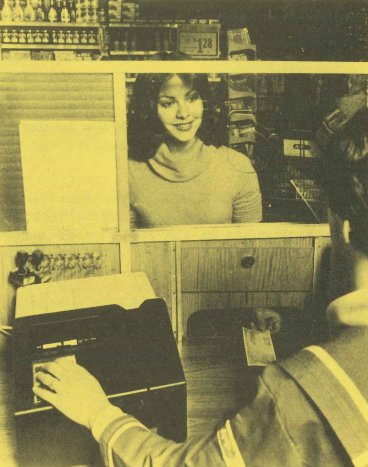
Photo credit: Hagley Museum and Archives Philadelphia Savings Fund Society Collection 2062 Box 13 PSFS Online News Bulleting, Vo 80-102, June 23 1980.
In the banking and financial industry new, transformative technologies thus began to be trialled and developed in order to make this a reality (Maixé-Altés, 2019). Financial institutions accepting retail deposits had been at the forefront of the adoption of commercial applications of computer technology (Bátiz-Lazo et al., 2011). Early forms of such technical devices mainly focused on improving “back office” operations and encompassed punch card electromechanical tabulators in the 1920s and 1930s; later, in the 1950s, analogue devices (such as the NCR Post Tronic of 1962) were introduced, and, in the late 1960s the IBM 360 became widely adopted. But at the same time, regulation curtailed diversification of products and geography (limiting the service banks could provide their customers). These regulatory restrictions help to explain ongoing experiments with a number of devices which involved a significant degree of consumer interaction including credit cards (Stearns, 2011), the use of pneumatic tubes and CCTV in drive through lanes, home banking, and Automated Teller Machines (ATMs), which despite being first introduced in the late 1960s and early 1970s, would ultimately not gain acceptance until the early 1980s (Bátiz-Lazo, 2018).
Like the banking and financial industry, the retail industry, with its very real interest in point of sale digitalization, was exposed to the rise of digital technology in the last quarter of the 20th Century. The digitalisation of retailing occurred later than in other industries in the American economy (for a European account see Maixé-Altés and Castro Balguer, 2015). Once it arrived, however, the adoption of a range of digital technologies including Point of Sale (POS) related innovations such as optical scanning, and the universal product code (UPC), were extensive and transformed the industry (Cortada, 2003). From the perspective of historical investigation, the chronological place of such innovation, beginning in the mid-1970s, is associated with a remarkable period of rapid technological change in U.S. retailing (Basker, 2012; Bucklin 1980). Along with rapid technological change, shifts in the structure of retail markets, in particular the decline of single “mom and pop stores” and the ascent of retail chains also became more pronounced in the 1970s (Jarmin, Klimek and Miranda, 2009). Two decades later, such large, retail firms would account for more than 50% of the total investment in all information technology by U.S. retailers (Doms, Jarmin and Kilmek, 2004).
What connects the transformative technological changes that occurred in both the banking industry and the retail industry during this period, is that both sought to utilise Electronic Funds Transfer Systems, or EFTS, a way to reduce frictions for retail payments at the point of sale. During the 1970s and 1980s, the term EFTS was used in a number of ways. Somewhat confusingly, it was applied indistinctively to specific devices or ensembles, value exchange networks, and what today we denominate as infrastructures and platforms. While referring to it as a systems technology for payments it was defined as one:
“in which the processing and communications necessary to effect economic exchange and the processing and communications necessary for the production and distribution of services incidental to economic exchange are dependent wholly or in large part on the use of electronics” (National Commission on Electronic Funds Transfer, 1977, 1).
Ultimately EFTS would come to be extended to the point of sale and embodied in terminals which allowed for automatic, digital, seamless transfer of money from the buyer’s current account to the retailer’s, known as the Electronic Funds Transfer at the Point of Sale, or EFTS-POS (Dictionary of Business and Management: 2016).
One of the factors that initially held back the adoption of early EFTS and the equipment that utilities it, was the lack of infrastructure that would connect the user, the retailer, and the bank (or wherever the user’s funds were stored). As Bátiz-Lazo et al. (2014) note the idea of a cashless economy that would provide this infrastructure was highly appealing… but implementing its actual configuration was highly problematic. Indeed, in contrast to developments in Europe, some lawmakers in Congress considered the idea of sharing infrastructure by banks as a competitive anathema (Sprague, 1977). Large retailers such as Sears had a national presence and were able to consider implementing their own solution to the infrastructure problem. Small banks looked at proposals by the likes of Citibank with scepticism while they feared it may pivot the dominance of large banks. George W. Mitchell (1904-1997), a member of the Board of the Federal Reserve, and management consultant John Diebold (1926-2005), were outspoken promoters of the adoption of cashless solutions but their lobbying of public and private spheres was not always successful. Perhaps the biggest chasm between banks and retailers though, resulted from the capital-intensive nature of the potential network and infrastructure that any form of EFTS required.
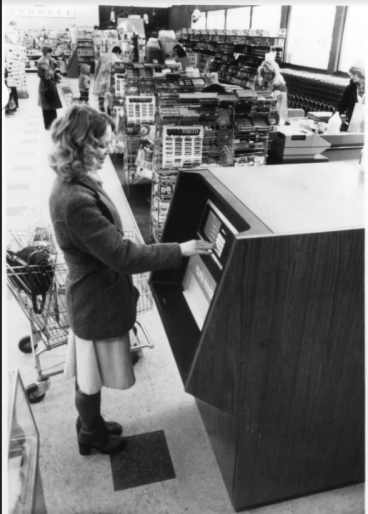
Photo credit: Courtesy of Diebold-Wincor Inc.
Amongst the alternative solutions that were trialled by banks and retailers, there were a number of successes, such as ATMs (Bátiz-Lazo, 2018) and credit cards (Ritzer, 2001; Stearns, 2011). Both bankers and retailers were quick to see a potential connection between the machine-readable cards and the rapid spread of new bank-issued credit cards under the new Interbank Association (i.e., the genesis of Mastercard) and the Bankamericard licensing system (i.e., the genesis of Visa), both of which began in 1966, just as the vision of the cashless society was winning acceptance. Surveys from the time indicate that at least 70 percent of bankers believed that credit cards were the first step toward the cashless society and that they were entering that business in order to be prepared for what they saw as an inevitable future (Bátiz-Lazo et al., 2014).
There were also a number of less successful attempts that, far from being relegated to the ignominy of the business archives, offer an important insight into the implementation of a cashless economy which is worth preserving for future generations of managers and scholars. Chief amongst these is a system widely deployed by the alliance of U.S. savings and loans (S&L) with mid-sized retailers under the sobriquet “Hinky Dinky”. Interestingly, Maixé-Altés (2012, 213-214) offers an account of a similar, independent, and contemporary experiment in, a very different context, Spain. The Hinky Dinky moniker was derived from an experiment by the Nebraskan First Federal Savings and Loan Association, which in 1974 located computer terminals into stores of the Hinky Dinky grocery chain - which at its apex operated some 50 stores across Iowa and Nebraska. The Hinky Dinky chain was seen by the First Federal Savings and Loan Association as the perfect retail partner for this experiment owing to the supermarket’s popularity with local customers; an appeal that would be beneficial to this new technology. The popularity of Hinky Dinky was particularly valuable, as the move by First Federal Savings and Loans, to establish an offsite transfer system challenged, but did not break banking law at that time (Ritzer, 1984).
At the heart of the technical EFT system initiated by First Federal, formally known as Transmatic Money Service, was a rudimentary, easy-to-install package featuring a point-of- service machine, with limited accessory equipment in the form of a keypad and magnetic character reader. The terminal housed in a dedicated booth within the store and was operated by store employees (making a further point of the separation between bank and retailer). The terminal enabled the verification and recording of transactions as well as the instant updating of accounts. The deployment of the terminals in Hinky Dinky stores shocked the financial industry because it made the Nebraska S&L appear to be engaging in banking activities, while the terminals themselves provided banking services to customers in a location that was not a licensed bank branch!
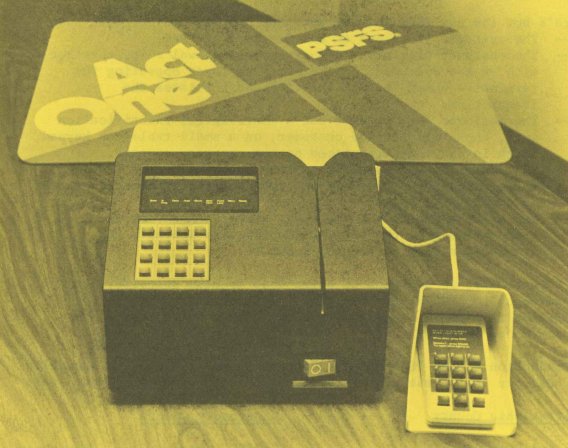
Photo credit: Hagley Museum and Archives Philadelphia Savings Fund Society Collection 2062 Box 13 PSFS Online News Bulleting, Vo 79-127, September 13, 1979.
From its origins in a mid-sized retail chain in the Midwest, some 160 “Hinky Dinky” networks appeared across the USA between 1974 and 1982, before S&Ls abandoned them in favour of ATMs and credit cards. These deployments included a roll out in 1980 by the largest savings banks by assets in the USA at the time, the Philadelphia Savings Fund Society or the PSFS. Rather than commit to the large capital investment that ATMs necessitated, without guarantees of its viability or a secure return on investment, the PSFS pivoted the “Hinky Dinky” terminals as part of the rolled out of its negotiable order of withdrawal (NOW) accounts (commercialised as “Act One”).
The NOW accounts were launched in the early 1970s by the Consumer Savings Bank, based in Worcester, MA (today part of USBank), as way to circumvent the ban on interest payment and current account deposits imposed on S&Ls by Depression era regulation. Between 1974 and 1980, Congress took incremental steps to allow NOW accounts nationwide, something the PSFS wanted to take advantage of. Consequently, in February 1979, the PSFS signed an agreement with the Great Atlantic and Pacific Tea Company (A&P) to install Transmatic Money Service devices in 12 supermarket locations. This was part of the PSFS wider strategy “to provide alternative means for delivering banking services to the public” (Hagley Archives: PSFS Collection).
These terminals did not, however, allow for the direct transfer of funds from the customer’s accounts to the retailers. Rather the terminals, which were operated by A&P employees, were activated by a PSFS plastic card that the society issued to customers, and enabled PSFS customers with a Payment and Savings account to make withdrawals and deposits. The terminals also allowed PSFS cardholders and A&P customers to cash cheques.
The equipment used by PSFS, the Hinky Dinky devices, therefore represent an interesting middle ground which improved transaction convenience for consumers, was low risk for the retailer and was relatively less costly for banks and financial institutions than ATMs (Benaroch & Kauffman, 2000).
One of the most interesting features of the Hinky Dinky terminals as they were deployed by the PSFS and First Federal Savings, was that they represent co-operative initiatives between retail organisations and financial institutions. As mentioned before, this was not necessarily the norm at the time. As the legal counsel to the National Retail Merchants Association (a voluntary non-profit trade association representing department, speciality and variety chain stores) wrote in 1972: “Major retailers… have not been EFTS laggards. However, their efforts have not necessarily or even particularly been channelled toward co-operative ventures with banks,” (Schuman, 1976, 828). These sentiments were echoed by more neutral commentators who similarly highlighted the lack of dialogue between retailers and financial institutions on the topic of EFTS (Sprague, 1974). The extent to which retailers provided financial services to their customers had long been a competitive issue in the retail industry: the ability of chain stores, such as A&P in groceries and F.W. Woolworth in general merchandise, to offer low prices and better value owed much to their elimination of credit and deliveries (Lebhar, 1952). With the advent of EFT retail organisation’s provision of financial services raised the prospect of this becoming a competitive issue between these two industries.

Photo credit: From J.C Penney 1959 Annual Report.
The prospect of a clash between retailers and banks was increased moreover, as there had always been other voices, other retailers, who had been willing to offer credit (Calder, 1999). In the early years of the 20th century, consumer demand for retailers to provide credit grew. This caused tension with the cash only policies of department store such as A.T. Stewart and Macy’s, and the mail order firms Sears Roebuck and Montgomery Ward (Howard, 2015). Nevertheless, it was hard to ignore such demand as evidenced by Sears decision to begin selling goods on instalment around 1911 (Emmet and Jeuck, 1950, 265). Twenty years later, in 1931, the company went a stage further by offering insurance products to consumers through the All State Insurance Company. Other large retail institutions, however, resisted the pressure to offer credit until much later (J.C. Penney for instance would not introduce credit until 1958). Credit activities by large retailers, nonetheless, were determinant for banks to explore their own credit cards as early as the 1940s while leading to the successes of Bankamericacard and the Interbank Association in the 1960s (Bátiz-Lazo and del Angel, 2018; Wolters, 2000).
The barriers between banks and financial institutions on the one hand, and retailers on the other, continued to remain fairly robust. Signs that this was beginning to change began to emerge in the 1980s, when retailers, such as Sears began to offer more complex financial products (Christiansen, 1987; Ghemawat, 1984; Raff and Temin, 1997). Yet, the more concerted activity by retailers to diversify into financial services, would ultimately be stimulated by food retailers (Martinelli and Sparks, 1999; Colgate and Alexander, 2002). The Hinky Dinky System however shows that a co-operative not just a competitive solution was a very real possibility.
In 2021 we are witnessing an extreme extension and intensification of these trends. Throughout the ongoing Covid-19 pandemic, the use of cash has greatly declined as more and more people switch to digital payments. In the retail industry, even before the pandemic, POS innovations were becoming increasingly digital (Reinartz and Imschloβ, 2017) as retailers shifted toward a concierge model of helping customers rather than simply focusing on processing transactions and delivering products (Brynjolfsson et al., 2013). Consequently, the retail-customer interface was already starting to shift away from one that prioritised the minimisation of transaction and information costs toward an interface which prioritised customer engagement and experience (Reinartz et al., 2019).
A second feature of the pandemic has been the massive increase in interest in crypto currencies, in its many different forms, around the world. This is most apparent in the volatility and fluctuations in price of Bitcoin but is also evident in the increased prominence of alternative fiat currencies (such as Ether). Indeed, even central banks in Europe and North America are discussing digital currencies, the government of El Salvador has made Bitcoin legal tender, while the People’s Bank of China have launched their own digital currency in China. A further manifestation of the momentum crypto currencies are gaining include the private initiatives of big tech (such as Facebook’s Diem, formerly Libra). Yet, in spite of all of this latent promise, transactions at point of sale with crypto currencies are still minuscule and time and again, surveys by central banks on payment preferences consistently report people want paper money to continue to play its historic role.
It thus remains too early to forecast with any degree of certainty what the actual long-run effects of the virus, social distancing and lockdowns will have on the use of cash, how consumers acquire products and services, and what these products and services are. It is also uncertain whether and if greater use of crypto currencies will lead to a decentralised management of monetary policy (and if so, the rate at which this will take place). It is though almost certain that consumer’s behaviours, expectations and habits will have been altered by their personal experiences of Covid. In this context the story behind “Hinky Dinky” reminds us to be sober at a time of environmental turbulence and wary of extrapolating trends, to better understand the motivation driving the adoption of new payment technology as some of these trends, like “Hinky Dinky”, might look to have wide acceptance but to result in a short-term phenomenon.
Acknowledgements
We appreciate helpful comments from Jeffrey Yost, Amanda Wick and J. Carles Maixé-Altés. As per usual, all shortcomings remain responsibilities of the authors.
Bibliography
Basker, E. (2012). Raising the Barcode Scanner: Technology and Productivity in the Retail Sector. American Economic Journal: Applied Economics, 4(3), 1-27.
Bátiz-Lazo, B. (2018). Cash and Dash: How ATMs and Computers Changed Banking. Oxford: Oxford University Press.
Bátiz-Lazo, B., Maixé-Altés, J. C., & Thomes, P. (2011). Technological Innovation in Retail Finance: International Historical Perspectives. London and New York: Routledge.
Bátiz-Lazo, B., Haigh, T., & Stearns, D. L. (2014). How the Future Shaped the Past: The Case of the Cashless Society. Enterprise & Society, 15(1), 103-131.
Bátiz-Lazo, B., & del Ángel, G. (2018). The Ascent of Plastic Money: International Adoption of the Bank Credit Card, 1950-1975. Business History Review, 92(3 (Autumn)), 509 - 533.
Bátiz-Lazo, B., & Wood, D. (2002). An Historical Appraisal of Information Technology in Commercial Banking. Electronic Markets - The International Journal of Electronic Commerce & Business Media, 12(3), 192-205.
Benaroch, M., & Kauffman, R. J. (2000). Justifying Electronic Banking Network Expansion Using Real Options Analysis. MIS quarterly, 197-225
Bucklin, L. P. (1980). Technological-change and Store Operations-The Supermarket Case. Journal of retailing, 56(1), 3-15.
Calder, L. (1999). Financing the American Dream: A Cultural History of Consumer Credit. Princeton: Princeton University Press.
Colgate, M., & Alexander, N. (2002). Benefits and Barriers of Product Augmentation: Retailers and Financial Services. Journal of Marketing Management, 18(1-2), 105-123.
Cortada, J. (2004). The Digital Hand, Vol 1: How Computers Changed the Work of American Manufacturing, Transportation, and Retail Industries. Oxford: Oxford University Press.
Chrstiansen, E. T. (1987) Sears, Roebuck & Company and the Retail Financial Services Industry (Part Two). Case 9-387-182. Cambridge, MA: Harvard Business School.
Doms, M. E., Jarmin, R. S., & Klimek, S. D. (2004). Information technology Investment and Firm Performance in US Retail Trade. Economics of Innovation and new Technology, 13(7), 595-613.
Emmet, B., Jeuck, J. E., & Rosenwald, E. G. (1950). Catalogues and Counters: A History of Sears, Roebuck and Company. Chicago: University of Chicago Press.
Ghemawat, P. (1984) Retail Financial Services Industry, 1984. Case 9-384-246, Cambridge, MA: Harvard Business School.
Hagley Museum and Archives Philadelphia Savings Fund Society Collection 2062 Box 13 POS Program Introduction March 2, 1978.
Howard, V. (2015). From Main Street to Mall: The Rise and Fall of the American Department Store. Philadelphia: University of Pennsylvania Press.
Jarmin, R. S., Klimek, S. D., & Miranda, J. (2009). The Role of Retail Chains: National, Regional and Industry results. In Producer dynamics: New evidence from micro data (pp. 237-262). Chicago: University of Chicago Press.
Lebhar, G. M. (1952). Chain stores in America, 1859-1950. New York: Chain Store Publishing Corporation.
Martinelli, E. and Sparks, L. (2003). Food Retailers and Financial Services in the UK: A Co‐opetitive Perspective", British Food Journal, Vol. 105 No. 9, pp. 577-590.
Maixé-Altés, J. C. (2012). Innovación y compromiso social. 60 años de informatización y crecimiento. Barcelona: "la Caixa" Group.
Maixé-Altés, J. C. (2019): "The Digitalisation of Banking: A New Perspective from the European Savings Banks Industry before the Internet," Enterprise and Society, Vol. 20, No. 1, pp. 159-198.
Maixé-Altés, J. C. (2020): "Retail Trade and Payment Innovations in the Digital Era: A Cross-Industry and Multi-Country Approach", Business History Vol. 62, No. 9, pp. 588-612.
Maixé-Altés, J. C. (2021): "Reliability and Security at the Dawn of Electronic Bank Transfers in the 1970s-1980s". Revista de Historia Industrial, Vol. 81, pp. 149-185.
Maixé-Altés, J. C. and Castro Balguer, R. (2015): "Structural Change in Peripheral European Markets. Spanish Grocery Retailing, 1950-2007", Journal of Macromarketing, Vol. 35, No. 4, pp. 448-465.
Raff, D., & Temin, P. (1999). Sears, Roebuck in the Twentieth Century: Competition, Complementarities, and the Problem of Wasting Assets. In Learning by doing in markets, firms, and countries (pp. 219-252). Chicago: University of Chicago Press.
Reinartz, W., & Imschloβ, M. (2017). From Point of Sale to Point of Need: How Digital Technology is Transforming Retailing. NIM Marketing Intelligence Review, 9(1), 42.
Reinartz, W., Wiegand, N., & Imschloβ, M. (2019). The Impact of Digital Transformation on the Retailing Value Chain. International Journal of Research in Marketing, 36(3), 350-366.
Ritzer, G. (2001). Explorations in the Sociology of Consumption: Fast Food, Credit Cards and Casinos. Thousand Oaks, CA: Sage Publishing.
Ritzer, J. (1984) Hinky Dinky Helped Spearhead POS, remote banking movement. Bank Systems and Equipment, December, 51-54.
Schuman, C. R. (1975). The Retail Merchants' Perspective Towards EFTS. Catholic University Law Review, 25(4), 823-842.
Sprague, R. E. (1977). Electronic Funds Transfer In Europe: Their Relevance for the United States. Savings Banks International, 3, 29-35.
Sprague, R.E. (1974) Electronic Funds Transfer System. The Status in Mid-1974 – Part 2. Computers and People 23(4).
Stearns, D. L. (2011). Electronic Value Exchange: Origins of the Visa Electronic Payment System. London: Springer-Verlag.
United States. National Commission on Electronic Funds Transfer. (1977). EFT and the public interest: a report of the National Commission on Electronic Fund Transfers. Second printing. Washington: National Commission on Electronic Fund Transfers.
Wolters, T. (2000). ‘Carry Your Credit in Your Pocket’: The Early History of the Credit Card at Bank of America and Chase Manhattan. Enterprise & Society, 1(2), 315-354.
Bátiz-Lazo, Bernardo and Buckley, Tom R. August (2021). “Early “Frictions” in the Transition towards Cashless Payments.” Interfaces: Essays and Reviews in Computing and Culture Vol. 2, Charles Babbage Institute, University of Minnesota, 64-75.
About the authors:
Dr. Bernardo Bátiz Lazo is Professor of FinTech History and Global Trade at Northumbria University in Newcastle upon Tyne, UK and research professor at Universidad Anahuac (Mexico). He is a fellow of the Royal Historical Society and the Academy of Social Sciences.
Dr. Tom Buckley is currently Lecturer in International Business Strategy at the University of Sheffield. Dr. Buckley received his PhD from the University of Reading’s Henley Business School in 2017.
Top 10 Signs We Are Talking About IBM’s Corporate Culture
James W. Cortada, Senior Research Fellow, Charles Babbage Institute
Abstract: Using the format of a late night TV humorist's way of discussing an issue, this article defines ten characteristics of IBM's corporate culture deemed core to the way IBM functioned in the twentieth century. The perspective is of the individual employee's behavior, conjuring up with humorous images what they thought of each other's behavior. However, corporate images are serious matters so as historians focus more attention on corporate cultures, such images will need to be understood. The list also demonstrates that one image of IBM personnel as being serious did not always reflect reality within the company.

Between 1982 and 2015, comedian and American television host David M. Letterman hosted a highly popular late-night television comedy show, Late Night with David Letterman. One of his recurring presentations was the “Top 10 List,” which ranked from tenth to first features of an issue. These became wildly popular, were satirized, and taken to be comedic commentary on contemporary circumstances. He and his staff produced nearly 700 such lists, while Letterman hosted over 6,000 programs viewed by millions of people. He published four book-length collections of these lists. The genius of these lists, as in any good comedy, lay in providing a slightly fractured view of reality. On occasion, he commented on corporations, such as GE, AT&T, Exxon, McDonalds, QVC and Westinghouse among others.
In recent years scholars have become increasingly interested in the history of corporate cultures. For decades historians said corporate cultures were important, but they did little work on the subject. That is beginning to change. I am exploring IBM’s corporate culture, which historians and employee memoirists all claim was central to the company’s ability to thrive and survive longer than any other firm in the IT industry. So, to do that historians have to find new types of documentation informing their study of the subject. That is why we are turning to comedian David Letterman. His lists reflected public interest in a topic, and they captured perspectives people would either agree with or that made sense to them given what they knew of the subject. What better way is there to see what IBM’s image looked like: “10 Signs you might be Working at IBM”:
“10. You lecture the neighborhood kids selling lemonade on ways to improve their process.”
Thomas J. Watson Sr., head of IBM from 1914 to 1956, made exploring with customers how best to use his tabulators, then computers, a central feature of his selling method. Tens of thousands of sales personnel did this. In the process they and other employees improved IBM’s operations and were seen as experts on efficient, productive business operations. As the company grew in size, so too did its reputation for having “its act together” on all manner of business and technical issues. That reputation expanded, crowned with the acquisition of 30,000 management and IT consultants from PwC in 2002. There was no industry or large company immune from IBM’s views on how to improve operations, nor community organization involving IBMers. (Side note: Your author—retired IBMer—taught his daughters how to improve their Girl Scout cookie sales process.)
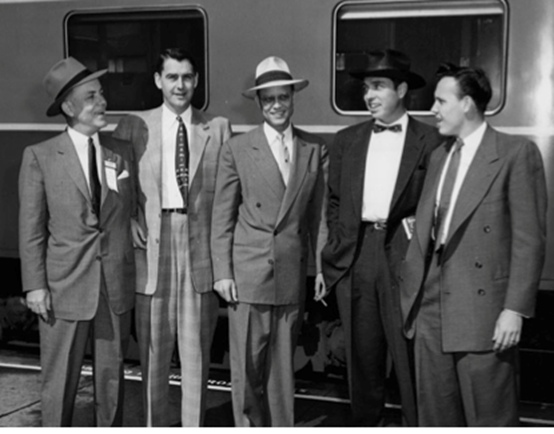
“9. You get all excited when it’s Saturday so you can wear shorts to work.”
The two things most people know about IBM in any decade is its THINK sign and that its employees always wore dark suits, white shirts, regimental ties, black socks and shoes. It turns out, they did that, not because someone at the top of the corporation mandated such a dress code, rather because that is how customers tended to dress. There was no official dress code, although most IBMers can tell a story of some lower level manager sending someone home to change out of their blue shirt or, shockingly out of their brown loafers. But Thomas J. Watson, Jr., CEO between 1956 and 1971 finally opined in the subject in 1971, confessing that IBM’s customers dressed in a “conservative” manner. He thought, “it is safe to say that the midstream of executive appearance is generally far behind the leading edge of fashion change.” So, “a salesman who dresses in a similar conservative style will offer little distraction from the main points of business discussion and will be more in tune with the thinking of the executive.” That is why, “we have always had a custom of conservative appearance in IBM.” People are thus asked, “to come to work appropriately dressed for their job environment.” That’s it: the smoking gun, the root source of the true IBM dress code policy! Millions of people have met IBM employees wearing blue suits. Sociologists point out that every profession has its uniform (e.g., university students blue jeans, cooks their tall white hats, IBMers their wingtips and white shirts). The Letterman quip inferred below is that IBM employees were willing to put in long hours on behalf of their company.
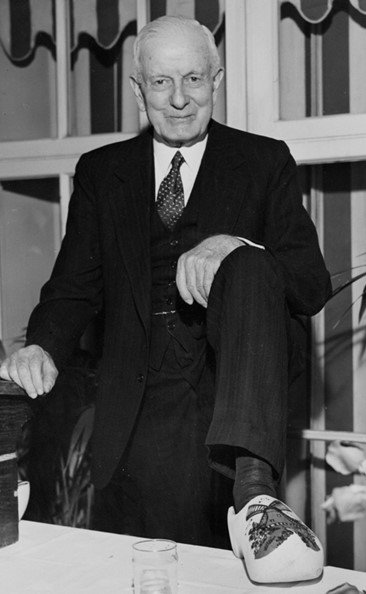
“8. You refer to the tomatoes grown in your garden as deliverables.”
Deliverables is a word with a long history at IBM, at least back to the 1950s. While its exact origins are yet to be uncovered, technical writers worked with product developers on a suite of publications that needed to accompany all product announcements or modifications to them. In fact, one could not complete a product development plan without including as one of its deliverables a communication plan in writing. The plan had to include when and how press releases, General Information and user and maintenance manuals would be published, and how these would accompany products to customers’ data centers. When IBM entered the services business focusing largely on doing management and strategy consulting in the 1990s with the creation of the IBM Consulting Group use of the word expanded across IBM. Management consultants in such firms as Ernest & Young, Booze Allen and McKinsey, among others, always concluded their consulting projects with a final report on findings and recommendations, which they, too, called deliverables. So as these people came to work at IBM, they brought with them their language. By the end of the 1990s, it seemed everyone was using deliverables to explain their work products. So, the Letterman List got right another IBM cultural trait that proved so pervasive that even employees did not realize they said deliverables.
“7. You find you really need Freelance to explain what you do for a living.”
Oh, this one hurts if you are an IBMer. The “Ouch” is caused by the fact that during the second half of the twentieth century, employees attended meetings armed with carefully prepared slide presentations. They began with Kodak film slides, then 8 x 10 film called foils (IBMers may have had an exclusive in using that word), followed by the precursor of PowerPoint called Freelance. Every manager it seemed carried a short presentation about their organization, what it did and so forth. By the end of the 1960s it seemed no proposal to a customer or higher-level manager was missing the obligatory presentation. When Louis V. Gerstner came to IBM as its new CEO in 1993, he immediately noticed this behavior and essentially outlawed the practice by his executives when meeting with him. He wanted them to look into his eyes and talk about “their business.” Eventually he retired and so by the early 2000s, PowerPoint was back. By the 2010s the nearly two hundred firms acquired by IBM came fully stocked with employees who, too, clutched their slide presentations. Edward Tufte, the Yale professor who is most noted for his multi-decade criticism of PowerPoint presentations, must clearly have had IBM in mind, although he admitted many corporations suffered from similar behavior. He went on to study the role of graphics and presentation of statistics and other data.
“6. You normally eat out of vending machines and at the most expensive restaurant in town within the same week.”
This observation required true insight. One of the TV writers must have interviewed a salesman, consultant, any manager or executive to stumble across this one. IBM people spent a considerable amount of time traveling to visit customers, attend internal and industry meetings, fulfill their normal requirement of two weeks of training every year, attend conferences to make presentations, or to meet with government officials. By the 1980s it was not uncommon for large swaths of IBM to be organized in some matrix manner in which one’s immediate supervisor was in another country while yet another manager with whom one had to work with was perched elsewhere. To kiss the ring, one had to travel to wherever that manager held court. Some professions, such as sales and consulting and middle and senior management, turned themselves into tens of thousands of “road warriors.” So, one might fly to a city and take a customer out to dinner at a magnificent restaurant to build personal rapport and to conduct business, in slang terms sometimes referred to as “tavern marketing.” But then afterwards rushed to the airport to catch the “red eye” overnight flight home or to some other destination to attend yet another meeting. That would require possibly eating vending machine food after an airport’s restaurants closed, at a work location that had no restaurant or when there was no time to rush out for something. IBMers, too, prided themselves in making their flights “just in time,” meaning no time for having a leisurely meal. You were complimented if you reached the airplane’s door just as it was about to be closed.
“5. You think that “progressing an action plan” and “calenderizing a project” are acceptable English phrases.”
Since at least the 1970s, employees putting together those famous slide presentations were retreating from writing full sentences, engaged in the very bad habit of turning nouns into verbs. Technical writers in the firm eschewed such behavior, so too the media relations community. Employees working in headquarter jobs in the United States, were particularly notorious users of nouns. Letterman may not have known of the most widely used example, “to solution” something or its variant “I will solution that problem.” The use of a noun was intended to project force, action, determination, and leadership. Nobody seemed embarrassed by their ignorance of the English language. If one worked in the same building as hundreds or thousands of people without visiting too many other workplaces, local speech patterns became evident. The New York area’s IBM community was notorious; they wanted people to come to them and when that happened visitors were abused with such language. As cultural anthropologists pointed out since Claude Levi-Strauss as early as the 1930s, tribes form their own language tied to their cultures and lifestyles. IBMers were guilty of the same. It is part of the behavior that led to such usages as “foils.”
“4. You know the people at faraway hotels better than your next-door neighbors.”
This has to qualify as true for some road warriors. It ties to No. 6 about vending machines. Consultants, in particular, would leave home on a Sunday night or Monday morning and not return until Friday night, if on long term projects. They were commuting and so when home, took care of domestic chores or spent time with their families. It was—is—not uncommon for employees to know the names of flight attendants and hotel staff, since those individuals, too, had set work schedules. Knowing the name of restaurant staff working near a client’s offices was—is—not uncommon, either. Such knowledge could be exotic, as knowing the flight attendant assigned to one’s Monday morning flight to Orange County, California, and at the same time the doorman at one’s favorite Lebanese restaurant in Paris. This is not conceit, just the reality that IBM employees did a considerable amount of traveling in the course of their career. It was both an attraction and a burden. Travel made work interesting but also placed a burden on one’s Circadian body rhythms not helped by rich food or vending machine delights.
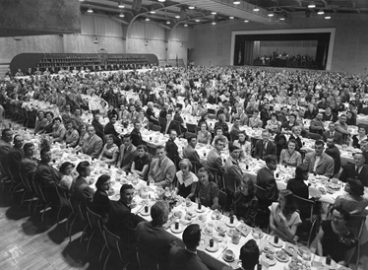
“3. You ask your friends to “think outside the box” when making Friday night plans.”
In IBM’s culture solving problems is a practice shared by all employees almost all the time. It became a worldview, a framework, and an attitude toward activities in both their professional and private lives. It has been fostered within the firm since the 1910s, largely because the products it sold required addressing customer issues and others challenging the internal operations at IBM. Over the years, language and phrases emerged that were embraced to speak to that issue. Thinking outside the box spoke to the need often required to come up with a solution to a problem that had not been tried before. That behavior prized imagination and equally so, a reluctance to accept no as an answer to a request. For a century, for example, salesmen and engineers were taught when encountering an objection or a problem not to take it personally, but to decompose it to understand what it really is, and then come up with a “fix” for it. There was an age-old sales adage that helps here: “The selling doesn’t start until the customer says no.” Flipping a “no” into a “yes” requires “thinking outside the box.” The same mindset was applied in one’s private life too.
“2. You think Einstein would have been more effective had he put his ideas into a matrix.”
Someone must have had spies in IBM or was a business school professor of organizational theory, because by the 1960s, much of IBM was organized like a matrix. As one student of IBM’s culture with experience studying corporate structures explained: “I’ve never seen this in any other company,” adding, “with all those dotted lines and multiple bosses.” However, it worked because everyone subscribed to a common set of values and behaviors, and all had documented performance plans that stated explicitly what they were to do. Where one sat in IBM insured that in everyone’s slide presentations there would be an organization chart to which the speaker could point out to explain where they perched. Another observer opined that, “It is probably the most complex organization that I have seen,” enter the illusion to smart Albert Einstein. Hundreds of thousands of employees lived in such matrices and somehow it all worked, because IBM made money and profits, with a few exceptions that Letterman and his audience might not even have been aware of, since most stockholders were the rich and institutional investors.
Following Letterman’s practice: “And the Number One Sign That You Work at IBM” with a drum roll, of course:
“1. … You think a ‘half-day’ means leaving at 5 o’clock.”
Employees had a work ethic that customers saw displayed in many ways: travel schedules, customer engineers working around the clock and over weekends to install and repair hardware and software, consultants who showed up at 8 in the morning and left at 7:30 to dine at one of those fine restaurants or to wolf down pizzas as they prepared for a client presentation to be made first thing in the morning. It was a life of endless dinners with clients and one’s management, or student teams working on case studies until midnight in some training program. Weekend planning retreats were all too common, especially in the fall as IBMers prepared for next year, or for spring reviews which were a ritual requiring weeks of preparation for when executive management would swoop in to inspect, often knowing as much about one’s business as the presenters. The company did nothing to hide the long hours its employees put in—it exemplified the wisdom of the Grand Bargain. This bargain held that in exchange for working loyally and to a great extent, one was assured a lifetime of employment at IBM. The 5 o’clock comment recognized that employees were seen as far more loyal to the firm and defender of its ways than evident in other companies. One sees such comments in bits and pieces in memoirs and accounts of the IT industry, but the Letterman list cleverly summed it up.
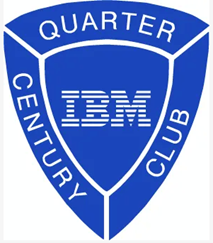
So, what was the image the Letterman List portrayed of IBMers to millions of people? While many had a good laugh, it affirmed that IBM’s employees were serious, knowledgeable, seemingly always on duty (even at home and in their neighborhood), focused on results, were imaginative, and had their own ways of doing and talking. IBM had purposefully worked on developing that image since the 1910s and a century later still retained it. It was part of a larger, hardly discussed, corporate strategy of creating an information/business ecosystem in the world of IT which it dominated.
But, of course, what Letterman may have missed are so many other lists, such as those hundreds of line items defining IBM (e.g., I’ve Been Moved). IBMers did not sleep wearing their black wingtip shoes, nor cut their lawns wearing white shirts. They actually had a sense of humor as historians are beginning to discover. IBMers conjured up comedic skits across the entire company around the world. They did standup joke telling, and, of course, sang songs, often with lyrics tailored to some Letterman-like observations about IBM.
But here is the punch line. Letterman never drew up this list, it is a spoof, prepared by an IBMer that circulated around the Internet. It was probably written in 1997, while IBM’s old culture was still much in place, when what was said here were IBM employee insights into the company’s culture. In short, there is more accuracy in this list than the comedian could have conjured up. But it was done so well that you have to admit, you believed it.
On a more serious note corporate image is an important issue. Today, for example, Facebook is being criticized for being irresponsible in supporting the flow of accurate information through society. It must have some employees who cringe that the driveway into their corporate headquarters is named Hacker Way, which suggests this is a company with teenage-like behavior when now it has become an important component of modern society. IBM studiously avoided such traps. Amazon, which enjoyed a positive image for years, recently was criticized for its working conditions that led to an attempted unionization effort at an Alabama facility, highlighting its aggressive actions to crush the initiative. President Joe Biden even supported publicly the unionizing effort. IBM never unionized in the United States, it never had a counter-culture name for a road and it never spoke about breaking things, rather about building them. From the beginning it wanted to be seen as a firm bigger than it was and as a serious, responsible pillar of society. Today’s business titans have much to learn from IBM’s experience.
One would wonder how Letterman would treat Apple, Microsoft, Facebook, Cisco, Amazon, Verizon, or Disney? He poked fun at other companies and, at least within IBM when he was popular on television, employees came up with their own Top 10 Lists all the time. If these other companies would be embarrassed by the humor, it suggests that Letterman has some business management lessons to teach them too.
Bibliography
Cortada, James W. (2019). The Rise and Fall and Reinvention of a Global Icon. Cambridge, Mass.: MIT Press.
Pugh, Emerson W. (1995). Building IBM: Shaping an Industry and Its Technology. Cambridge, Mass.: MIT Press.
Watson, Thomas J., Jr. (1963, 2000). A Business and Its Beliefs: The Ideas that Helped Build IBM. New York: McGraw-Hill.
___________ and Peter Petre. (1990). Father, Son, and Co.: My Life at IBM and Beyond. New York: Bantam.
Cortada, James W. (July 2021). “Top 10 Signs We Are Talking About IBM’s Corporate Culture." Interfaces: Essays and Reviews in Computing and Culture Vol. 2, Charles Babbage Institute, University of Minnesota, 55-63.
About the author: James W. Cortada is a Senior Research Fellow at the Charles Babbage Institute, University of Minnesota—Twin Cities. He conducts research on the history of information and computing in business. He is the author of IBM: The Rise and Fall and Reinvention of a Global Icon (MIT Press, 2019). He is currently conducting research on the role of information ecosystems and infrastructures.
NFTs, Digital Scarcity, and the Computational Aura
Annette Vee, University of Pittsburgh
Abstract: Here, I draw on Walter Benjamin’s discussion of the aura of original art in “The Work of Art in the Age of Mechanical Reproduction” to explore the appeal of NFTs (non-fungible tokens) in the age of digital reproduction. I explain what NFTs on the blockchain are and point to other attempts at scarcity in digital contexts, including Cryptokitties and the Wu-Tang Clan’s Once Upon a Time in Shaolin. Just as Bitcoin emerged from the 2008 financial crisis, NFTs have gained traction in the Covid-19 pandemic, demonstrating that scarce, rivalrous, positional goods are desirable even when computational networks afford perfect replication at scale.
*Please note: Explicit language quoted in this article may be offensive to some readers.
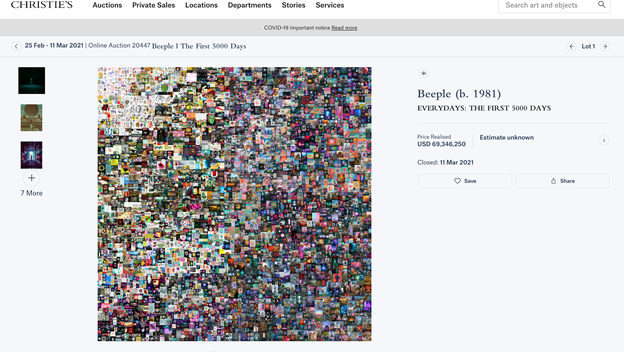
“holy fuck.” Beeple tweeted on 10:42AM Mar 11, 2021, when his artwork “Everydays: The First 5000 Days,” a jpg file measuring 21,069 pixels square, sold for $69,346,250 at auction on Christie’s online. Holy fuck, indeed: the first all-digital artwork sold at Christie’s—a composite of edgy, meme-worthy images the artist had posted every day since 2007--fetched a price in the same league as works by van Gogh, Picasso, Rothko and Warhol. In 1987, another Christie’s auction made headlines: Vincent van Gogh’s Still Life: Vase with Fifteen Sunflowers (“Sunflowers”) sold for nearly $40 million, tripling the record from any previous sale of art. Putting aside comparative judgements of quality, the nearly $70 million for Everydays was a lot of money to pay for a piece of art that could be perfectly replicated and stored on any given laptop. What made Everydays more like Sunflowers than millions of other jpgs?
Everydays was minted on 16 February 2021 and assigned a non-fungible token (NFT) on the Ethereum blockchain. This NFT authenticates Everydays and makes it unique from another bit-for-bit copy of the same file. Where a van Gogh listing on Christie’s site might declare medium, date, and location (e.g, oil on canvas, 1888, Arles), Everydays lists pixel dimensions, a token ID, wallet address, and smart contract address. In a Special Note on the Everydays auction, Christie’s declared it would accept the cryptocurrency Ether, but only in digital wallets hosted by a select group of platforms. Implicit in the listing of these addresses, the token ID, and trusted platforms is an attempt at digital authenticity.
Digital reproduction enables exact copies of art. Even when artists employ watermarks to encourage payment for digital art, the same tools that make the images and mark them can be used to restore and replicate them. NFTs secure digital art not by changing the file itself, but by changing its provenance. NFTs attach a unique identifier, or token, to represent the art on the blockchain. Their non-fungibility differentiates them from cryptocurrency relying on the blockchain. Bitcoin or Ether, for example, are fungible: any Bitcoin spends the same as any other Bitcoin. And like the fiat currency of the dollar, Bitcoin can be spent anywhere that particular cryptocurrency is accepted. In contrast, a non-fungible token is intentionally unique and cannot be spent. But because any given NFT or cryptocoin has a unique position on the blockchain, they cannot be counterfeited. Blockchain security relies on long chains of transactions, each dependent on the previous transaction, with the entire series of transactions made public. Altering one transaction would require altering the copy of the record decentrally stored across thousands of machines simultaneously. In other words, it's effectively impossible.
When a digital piece of art has an NFT associated with it, it’s been marked as authentic by the artist or an agent with the power to authenticate it. While the digital art itself might be able to be reproduced, the version that’s on auction ostensibly has the imprimatur of the creator. It’s been digitally touched by the artist. You can, too, own an exact copy of Everydays by downloading it here. But you can’t be part of the transaction that was recorded on the Ethereum blockchain, which involved Beeple transferring the token to the winner of the auction. (For more details on the exact chain of transactions from digital file to blockchain to auction and purchase, Robert Graham offers a more technical breakdown.)
Renaissance artists such as Leonardo da Vinci painted in a studio with the help of assistants. What makes a da Vinci a da Vinci isn’t that he painted all of it, but that he painted at least some of it, and that a community of experts take some responsibility for the claim that (Langmead et al.). We can compare a da Vinci painting to Jack Dorsey’s first tweet, which has been reproduced everywhere but is now associated with an NFT (Boucher). It’s like having Jack Dorsey touch the tweet before selling it, adding his splash of paint. The scarcity is what makes it valuable; the NFT buyer owns something that others do not and cannot. One of the reasons that Salvator Mundi sold for $450 million—shattering all previous records for art auctions—is that it is one of only 20 paintings attributed to da Vinci (Langmead, et al.). Dead artists generally fetch more for their work than living artists because they aren’t making any more art (Jeff Koons holds the living artist record for his metal sculpture Rabbit, sold at 91.1 million in 2019). For NFTs as well as physical art, scarcity depends on human trust in the creator as well as the system that verifies its connection with the creator.

I own a version of Still Life: Vase with Fifteen Sunflowers, which hangs on a wall in my family room. This Sunflowers is an original piece of art, has a traceable provenance, and is beautiful. It has an aura just as the one that auctioned for nearly $40 million in 1987. But the reason my copy wouldn’t fetch the same price at auction (though I admit I haven’t tried) is that the artist is Steven Vee--my dad. His paintings are highly valued in the diaspora of my hometown but are unknown to the van Gogh connoisseurs who bid at Christie’s. There’s the matter of the work’s age (15 years vs. 100 years) and materials (acrylic vs. oil paints). But the main difference between the two pieces of art is their aura: who imbued them with the aura, how they painted them, where, and who has owned them. My Sunflowers is valuable to me, but probably not to Christie's. (Although if it were, I would let it go for a mere $20million—sorry, Dad.)
Digital scarcity
Scarcity is a default attribute for a physical piece of art: both Vincent van Gogh's Sunflowers and Steve Vee's Sunflowers have multiple versions, but each individual painting is unique. Artificial scarcity has been the primary solution to the aura problem for mechanical reproduction of art. Limited print runs can ensure that a collector has one of only 20 prints, even if it’s technically possible to produce hundreds of them. Although the print may not be directly touched by the creator, its scarcity gives it value.
But scarcity is tricky with digital work. The fact that digital files are perfectly and infinitely reproducible makes it difficult to limit copies, at least once a digital file is released to another party. Perfect replication is one of the advantages of digitality, but it works against exclusive ownership. NFTs are a solution to this problem, but there have been others, each specific to its digital and social context.
In virtual spaces, scarcity emulates physical spaces. In the virtual world of Second Life, which was popular in the early 2000s and had a GDP to rival Samoa in 2009, users can build and buy property (Fleming). While the number of islands on which to build is theoretically infinite, the particular island and construction is ensured to be unique because the world is hosted by one company, Linden Lab. In Second Life, particular goods and construction could be copied and were the subject of intellectual property debates and court cases. And property ownership is subject to Linden Lab’s continued management and discretion.

In high-stakes online poker in the early 2000s, big-time players sold expensive coaching manuals as pdf files, and protected their scarcity by introducing a small variation in the version—an extra comma on page 34, for instance (Laquintano). It’s very easy to circulate a pdf: pdfs have a small file size and are easily stored and read on default programs on consumer machines. But anyone paying that much for a pdf wants security in knowing that their pdf won’t circulate easily, especially since the manuals contained poker strategies, so, like limited print runs, the pdfs lose value the more widely they are held. If the pdf manual got out, an author could trace the particular variation back to the original buyer and enforce the sales contract with social consequences in the poker community.
Another tactic to make a digital work scarce is to keep it out of digital networks altogether. This was Cilvaringz and RZA’s tactic with the Wu-Tang Clan’s 2015 album Once Upon a Time in Shaolin. Just one copy of the album was pressed, put in a bejeweled silver box with leather-bound liner notes, then put up for auction, where it fetched $2 million. The book accompanying the album says specifically: “This book has not been catalogued with the Library of Congress." The scarcity was ensured through the singular pressing as well as an agreement forbidding the buyer to exploit it commercially for 88 years (though it didn't curtail free distribution). The buyer later turned out to be the infamous Martin “Pharmabro” Shkreli, the album was seized by the US government in trial, and Shkreli finally streamed it in celebration of Trump’s victory in 2016.
With Once Upon a Time in Shaolin, the Wu-Tang Clan recaptured the aura of original art in digital music. Cilvaringz and RZA were frustrated at the devaluing of music through pirating and streaming and sought to make Once Upon a Time in Shaolin an art object. In an interview with Rolling Stone, RZA said, "It's kind of crazy. The record has become an entity, very different from a lot of albums. It's like the Mona Lisa. It's got its own folklore, and that's what me and [co-producer] Cilvaringz wanted." Speaking of digitized music, RZA said, “OK, nobody don't see the value on it, and we gonna put a value on it. We wanna say, 'This is what we think it's worth'" (Grow). On the album’s website, they channel Benjamin’s description of the aura in the age of mechanical reproduction:
Mass replication has fundamentally changed the way we view a recorded piece of music, while digital universality and vanishing physicality have broken our emotional bond with a piece of music as an artwork and a deeply personal treasure. […] We hope to inspire and intensify urgent debate about the future of music, both economically and in how our generation experiences it. We hope to steer those debates toward more radical solutions and provoke questions about the value and perception of music as a work of art in today’s world.
While a singular, high-profile release of an album might not be a general solution to the aura problem of digital art, it certainly worked for the Wu-Tang Clan.

Enter the Blockchain
Blockchain technology enables new approaches to artificial scarcity for digital work. The protocol for the blockchain was specified with the release of a white paper describing Bitcoin currency by Satoshi Nakomoto (a pseudonym) in 2008, at the height of the financial crisis. The protocol Nakomoto described took care of several problems with cashless digital transactions, including authorization, privacy, and double-spending. Prior to the Nakomoto white paper, it was only possible to check these boxes with the help of a trusted financial institution. Another problem with previous attempts at digital currency was uptake, or literal buy-in. In 2008, with trust in these institutions at a nadir, Bitcoin was a revelation (Brunton). People were ready to trust a new computational protocol.
Blockchain is essentially a ledger of transactions, with each transaction occupying a unique position on the ledger’s chain of records. The ledger is recorded not centrally in a bank’s records, but decentrally, on the computers of the participants. The ledger of record is determined by consensus and influenced by who carries the record of the longest chain of transactions. So it’s not possible for an interloper to drop in and change the consensus ledger, unless they somehow control 51% of the participating recorders.
Transactions are grouped into blocks to be verified by participants, who must crack a complex computational problem to verify the block. This process is called “proof of work” because the problem requires a huge amount of computational brute force to solve. Participants, called "miners" because they are mining for computational solutions, are incentivized to verify blocks with a chance to earn cryptocurrency if they are the first to crack the problem. The enticing incentive to verify transactions along with the huge expenditure of resources required to solve the problem—which is intentionally and arbitrarily difficult—is why cryptocurrency is so environmentally destructive. Computation requires energy, and millions of competing processors dedicated to solving an intentionally difficult problem adds up to a lot of energy expenditure.
To combat the wasted energy problem, “proof of stake” is a newer alternative to “proof of work” for block verification. Proof of stake effectively lets people bet their assets on their verification. Someone would need to control 51% of any cryptocurrency in order to defraud the ledger. For a cryptocurrency like Algorand, which uses proof of stake, the use of arbitrary and secret selection of block certifiers makes it especially difficult to corrupt enough users to defraud the ledger. Proof of stake routes around brute force computation and thus some of the environmental destruction of blockchain. Rather than favoring the biggest processors, it favors the biggest accounts.
The auras of assets other than money
Any currency is just an abstract representation of value, and so after the Bitcoin white paper, it didn’t take long to figure out how to put assets other than currency on the blockchain. Through smart contracts, the Ethereum protocol enabled property and digital art to record value on the blockchain. A smart contract is a block of code that can automatically execute the terms of a contract. For instance, a smart contract can enable cryptocurrency to be exchanged in response to a triggering event like a digital file transfer and then record the transaction on a blockchain. To integrate non-digital information as an event—say, a death in the case of a will—a smart contract relies on a trusted “oracle” such as a newspaper record (or an oracle network such as Chainlink) to convert that information and trigger a distribution of assets. Many cryptocurrency protocols now include code execution, along with scripting languages and other infrastructure, to enable such smart contracts. Ethereum is the most popular of these protocols for NFTs.
Decentraland is a more recent take on a virtual world like Second Life, with real property rights in virtual spaces, but instead of centralized control such as in Second Life, Decentraland is controlled by users and the technology of the DAO (Decentralized Autonomous Organization) made possible on the blockchain. Decentraland ties virtual land purchases to NFTs recorded on the Ethereum blockchain.

In 2017, the site Cryptokitties launched virtual collectible kitties that were registered as NFTs on the Ethereum blockchain. Cryptokitties emulate the artificial scarcity of baseball cards and Pokémon, but use the NFT protocol instead of physical cards to ensure that scarcity. Cryptokitties have a unique slate of traits (“Cattributes”), are released in generations, and can be bred to make more kitties. Cryptokitties are cute and silly, but they are actual assets on the blockchain and have actual (though widely varying) value in Ether (Ethereum’s cryptocurrency). The developers of Cryptokitties set out with a goal of introducing new users to cryptocurrency. Cryptokitties are, then, cute missionaries for a new financial order.
Cryptokitties have as much value as any collectible item like Beanie Babies and Pokémon cards. The developers, who refer to Cryptokitties as a kind of game, write,
Users spend 10-100x more on NFT assets than typical “in-game” digital assets because NFTs guarantee authenticity, scarcity, durability, and true ownership, which means NFTs have something very few digital components currently have: tradable value outside the ecosystem in which they were created. As an owner, I can sell my NFT assets at any given time – or I can keep them forever, passing them on like a family heirloom, from one generation to the next.
Gen Z+1 is certainly looking forward to receiving their cedar chest/Ethereum wallets of Diamond-gene Kitties.
NBA’s Top Shot is directly emulating the marketplace of sports cards through NFTs of “Moments” collected into Packs. Top Shot Moments give you the opportunity to “own your fandom.” The moments are “limited edition guaranteed by the blockchain” and are classified as Common, Rare and Legendary. In March 2021, Packs vary from $9 (Common) to $999 (Legendary). Two million Moments have been sold in the Marketplace, and the Legendary Steph Curry Dec 15, 2019 jumpshot, NY v. Cali, #1/4000 edition, is currently priced at $3,333. Anyone could find a clip of this jump shot on YouTube, and so the NBA has designed the Top Shot Moments to be more sophisticated than clips—they’re slick virtual cubes displaying stats along with video. But what distinguishes Top Shots from video clips is the artificial scarcity of exclusive ownership "guaranteed by the blockchain."
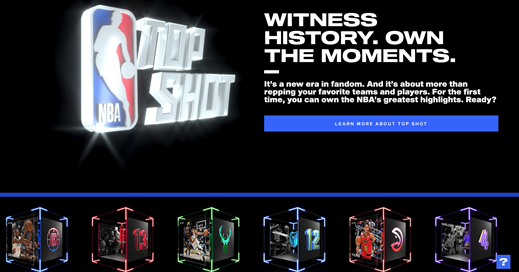
Cryptokitties and Top Shot Moments are infusing value into bits by making them scarce and capitalizing on the human propensity to hoard scarce goods. Artist Kevin Abosch calls NFTs “layers of hexadecimal code, alphanumerical proxies to distill emotional value” (Schachter). The blockchain platform has made waves in its creation of speculative capital, but with NFTs it creates emotional value as well. The blockchain registers auras.
Help someone stole my Internet tulips
The current bubble of speculation on blockchain based assets is part of the excitement. What NFTs are worth is determined by what others think they are worth—which is the same as in the physical art market, too. And the same for countless other speculative bubbles such as the Dutch tulip bubble in 1636 and the South Sea bubble in 1720, which caused Pope, Swift and many others to lose money and prompted Daniel DeFoe to call finance “Air-Money.” As Gayle Rogers details in a new book, Speculation, the risks and excitement of finance and investment have a long history. With wild speculation comes fraud and theft. As in the 2008 housing bubble, if the value of an asset keeps increasing, the incentive to verify it decreases. Buy in, cash out before the bubble bursts.
The information an NFT stores on the blockchain is effectively a link to the artwork and its metadata about the artist and provenance. The blockchain information might be immutable, but what it points to can be unstable, as Jonty Wareing recently pointed out. Artists such as Beeple and Grimes use IPFS (Interplanetary File System) to host this information. More secure than a URL, which is generally reliant on one host, the IPFS allows multiple hosts for content. But with hosting distributed, no particular host has a responsibility to keep the files online (Kastrenakes). And when files go offline, there is no verification for the NFT. CheckMyNFT, a site spun up just recently in response to the NFT craze, checks whether NFTs are hosted and verified. The site has found that even high-priced NFTs by high-profile artists go offline regularly. And if the blockchain register points to an empty address, an NFT is merely an Air-Asset. Ownership of the NFT then boils down to a digital paper trail of provenance, effectively ending at: “Trust me, I own these bits.”
An artist can theoretically "touch" multiple versions of the same piece of art—that is, mint multiple NFTs for identical pieces. That's because NFTs do not confer copyrights and there's no such thing as an "original" digital file. Since there's nothing stopping an artist from minting multiple NFTs for the same item, again, it’s trust that makes an NFT valuable. Also, without a central certification system for artists and agents, there's not much to prevent someone from fraudulently claiming to represent an artist and issuing NFTs. So, an NFT's value is contingent on whether the community of potential buyers trusts the artist, agent, and the art's authentic connection to both.
Outright theft of NFTs is also perhaps a greater risk than it is for physical assets. You just need someone’s password to their digital wallet. And as the digital security community often says, the weakest link in the chain is always the human. Passwords can be easy to crack or inadvertently shared. The security of any digital wallet depends on the security of its hosting service as well. In its auction of Everydays, Christie’s wisely specified which wallet hosting services it would accept.

As Michael Miraflor discovered when his NFTs were stolen on Nifty Gateway, the “trustless” virtue of the blockchain means human coordination is less necessary, but it also means that coordination and trust is unavailable when the system encounters problems like theft. Whoever has the NFTs owns the NFTs, regardless of how they got them. When his NFTs were stolen, Miraflor was able to get charges reversed on his credit card; however, he could not recover the stolen NFTs because transactions on the blockchain cannot be reversed by design. So the NFTs now belong to someone else, and the system is working as intended (@phantsy_prantz). Many commenters on Miraflor's Twitter thread were unsympathetic about the theft of virtual assets. @HeadlightsGoUp alluded to Miraflor’s participation in an NFT bubble: “Help someone stole my Internet tulips.”
And just as an owner of a physical artwork can burn it or throw it away, so can owners of NFTs. Ox_b1, “a pseudo anonymous crypto whale” who has over $500 million in crypto assets, bought a piece of NFT art by Lindsay Lohan for $43K in Ether and asked a community what to do with the asset. They voted to burn it. So, Ox_b1 transferred the NFT to a burn address: 0x00000. And poof, it’s gone. “NFT-dom is not all bad!” artist Kenny Schachter declared. Nice to watch celebrities get their just desserts, although Lohan still profited from the sale.
And what about the most valuable NFT art of all, Everydays? If you would like to download your very own identical copy of it, you can here on IPFS Gateway, using the hash of the file. The hash is a mathematical output of an algorithm run on a digital file. Different digital files, even if they’re visually similar, will produce different hashes. Thus, a hash is a way of verifying a file or an exact copy of a file. If you download that exact copy of Everydays, you’ll even have the right hash. You won’t own the copyright to it, but neither does Metakovan, who paid $69 million for it. Beeple, just like any other artist selling their work, retains copyright of a work upon its sale unless otherwise stated.
So, what Metakovan purchased for nearly $69 million isn’t the art or the copyright, but a place on an immutable, public transaction record—and a lot of media coverage. As Kal Raustiala and Christopher Jon Sprigman point out, Everydays is a “virtual Veblen good,” or a kind of good one purchases because it is expensive. Thorsten Veblen described the phenomenon of “conspicuous consumption,” especially among the newly wealthy. The value of the good is the social status it confers. Metakovan, the purchaser of Everydays, was behind a Beeple museum on the virtual world Cryptovoxels. As art critic Ben Davis describes, the museum isn’t a particularly good place to show Beeple’s artwork—but it is instead a platform for buying B.20 tokens, or partial shares in the Beeple collection. Beeple’s NFT artwork purchased by crypto-speculators serves, then, as a portfolio for further crypto speculation. We can all get in on the virtual ground floor.
NFTs rely on a chain of social valuation tied to digital scarcity, and that scarcity contributes to value. But the supposed scarcity of NFTs relies on a chain of humans, massive computational expenditure, file hosts, trust in digital registers, and speculation on social value. Which means their value is dependent on people, art, finance, and digital security all at once. No wonder many call NFTs a “house of cards.”

NFTs as a novel nexus of art and value
Like Bitcoin, NFTs arose to prominence in a crisis, and both have been both a reflection and a response to the specific nature of that crisis. As during the banking crisis of 2008, during the Covid-19 pandemic of 2020-21, the ground is primed for radical rethinking of value that RZA and Cilvaringz asked for. We’re all jolted out of our routines, physical trading and transport of goods is limited, cryptocurrency has gained a foothold in mainstream finance, and we’re bolted to our computers with only virtual materials as a means of creation. Out of this context, NFTs evolved a novel nexus of art and value.
But while this particular nexus might be new, attempts at value and scarcity with new technological platforms is not. Manufacturing, film, and photography prompted Benjamin to consider how artificial scarcity contributed to the aura of art. That we now instill emotional value in digital art, blockchain registers, an Interplanetary File System, and non-fungible tokens is another reminder that technology echoes humanity. We have created scarce, rivalrous, positional goods even when replication and scale are key affordances of computation.
Acknowledgments: Thank you to Alexandria Lockett for inspiring this piece by pointing me to the Beeple sale and asking my thoughts. I am also grateful to Tim Laquintano, Alison Langmead, and Gayle Rogers for feedback on the draft in process and to Steve Vee, @vivideman, and Karl Stomberg for letting me feature their art. Thanks also to Jeffrey Yost and Amanda Wick for launching an open access platform for this kind of work, as well as helpful comments on the draft.
Bibliography
@beeple. “holy fuck.” Twitter, 11 Mar. 2021, 10:42 a.m., https://twitter.com/beeple/status/1370037462085595137.
Benjamin, Walter. (1968). “The Work of Art in the Age of Mechanical Reproduction.” Illuminations, edited by Hannah Arendt, Fontana, pp. 214–18.
Boucher, Brian. (2021). “Twitter Founder Jack Dorsey Is Auctioning Off the World’s First Ever Tweet as an NFT—and the High Bid Is Already $2.5 Million.” Artnet, March 2021. https://news.artnet.com/market/jack-dorsey-nft-tweet-1950279.
Brunton, Finn. (2019). Digital Cash: The Unknown History of the Anarchists, Utopians, and Technologists Who Created Cryptocurrency. Princeton University Press.
“Check My NFT.” Check My NFT, https://checkmynft.com/. Accessed 9 Apr. 2021.
“Cryptokitties.” Cryptokitties, https://www.cryptokitties.co/. Accessed 9 Apr. 2021.
Davis, Ben. (2021). “I Visited the Digital Beeple Art Museum and All I Got Was an Aggressive Pitch for My Money.” Artnet, March 25,2021. https://news.artnet.com/opinion/beeple-b-20Museum review-1954174.
“Decentraland.” Decentraland, https://decentraland.org/. Accessed 9 Apr. 2021.
Fleming, Nic. (2009). “Virtual World Theft Heads to Real Life Court.” Computer Weekly, https://www.computerweekly.com/news/1280090966/Virtual-world-theft-heads-to-reallifecourt.
Graham, Robert. (March 20, 2021). “Deconstructing that $69million NFT.” Security Boulevard, https://securityboulevard.com/2021/03/deconstructing-that-69million-nft/.
Grow, Kory. (2018). “RZA Wanted to Buy Martin Shkreli’s Wu-Tang Album Back for Himself.” Rolling Stone, https://www.rollingstone.com/music/features/rza-talks-martin-shkrelshaolin-wu-tang-album-w518574.
@HeadlightsGoUp. “Help someone stole my internet tulips.” Twitter, 15 March 2021, 11:05 a.m., https://twitter.com/HeadlightsGoUp/status/1371477584781979650.
@jonty. “Out of curiosity I dug into how NFT's actually reference the media you're "buying" and my eyebrows are now orbiting the moon.” Twitter, 17 March 2021, 8:30 a.m. https://twitter.com/jonty/status/1372163423446917122
@kennyschac. Someone bought #lindsaylohan nft and destroyed it. C’mon you must admit NFTdom is not all bad!” Twitter, 11 Mar 2021, 8:40 a.m. https://twitter.com/kennyschac/status/1370006659096064007.
Kastrenakes, Jacob. (2021). “Your Million Dollar NFT Can Break Tomorrow If You’re Not Careful.” The Verge, March 2021. https://www.theverge.com/2021/3/25/22349242/nftmetadataexplainedart-crypto-urls-links ipfs.
Langmead, Alison, et al. (2021). “Leonardo, Morelli, and the Computational Mirror.” Digital Humanities Quarterly, vol. 15, no. 1, http://www.digitalhumanities.org/dhq/vol/15/1/000540/000540.html.
Laquintano, Timothy. (2016). Mass Authorship and the Rise of Self-Publishing. University of Iowa Press.
@michaelmiraflor. “Someone stole my NFTs today on @niftygateway and purchased $10K++ worth of today's drop without my knowledge. NFTs were then transferred to another account. I encourage EVERYONE to please check their accounts ASAP. Could use everyone's help here please RT!” Twitter, 14 March 2021, 4:39 p.m., https://twitter.com/michaelmiraflor/status/1371199359996456960.
“NBA Top Shot.” NBA Top Shot, https://nbatopshot.com/. Accessed 9 Apr. 2021.
“Online Auction 20447.” (March 11, 2021). Christie’s, https://onlineonly.christies.com/s/beeplefirst5000-days/beeple-b-1981-1/112924.
@phantsy_prantz. “it's literally impossible by design you clearly don't understand the technology very well by the terms of ‘ownership’ of an NFT, the new owner is the only owner of those tokens, regardless of anyone's feelings this is the system working as intended.” 17 Mar., 2021, 1:17 p.m., https://twitter.com/phantsy_prantz/status/1371510963405529090.
Rogers, Gayle (2021). Speculation: A Cultural History from Aristotle to AI. Columbia University Press.
Raustiala, Kal and Christopher Jon Sprigman (2021). “The One Redeeming Quality of NFTs Might Not Even Exist.” Slate, April 14, 2021. https://slate.com/technology/2021/04/nftsdigital-art-authenticity-problem.html.
Schachter, Kenny. (2021). “Are NFTs the Next Tulip Bubble? Kenny Schachter Doesn’t Car and He Sold His Own Grandma on the Crypto Web to Prove It.” Artnet, Mar. 2021. https://news.artnet.com/opinion/kenny-schachter-on-nfts-continued-1950407.
“Second Life.” Second Life, https://secondlife.com/. Accessed 9 Apr. 2021.
Vee, Annette. (June 2021). “NFTs, Digital Scarcity, and the Computational Aura." Interfaces: Essays and Reviews in Computing and Culture Vol. 2, Charles Babbage Institute, University of Minnesota, 38-54.
About the author:
Annette Vee is Associate Professor of English and Director of the Composition Program, where she teaches undergraduate and graduate courses in writing, digital composition, materiality, and literacy. Her teaching, research and service all dwell at the intersections between computation and writing. She is the author of Coding Literacy (MIT Press, 2017), which demonstrates how the theoretical tools of literacy can help us understand computer programming in its historical, social and conceptual contexts.
Everyday Information Studies: The Case of Deciding Where to Live
Melissa G. Ocepek and William Aspray
Abstract: This essay introduces everyday information studies to historians of computing. This topic falls within the subdiscipline of information behavior, one of the main subject areas in information studies. We use our recent edited book, on Deciding Where to Live (Rowman & Littlefield, 2021), as a means to illustrate the kinds of topics addressed and methods used in everyday information studies. We also point the reader to some other leading examples of scholarship in this field and to two books that present an overview of the study of information behavior.
This essay introduces everyday information studies to historians of computing. The story of this field of study and its history are too large to tell in detail here. This topic falls within the subdiscipline of information behavior, one of the main subject areas in information studies – a field that began to be studied between the two world wars and took off in the 1960s. The reader interested in information behavior studies more generally should examine two well-regarded reference works on this subject (Case and Given 2016; Fisher, Erdelez, and McKechnie 2005).
Information Study Approaches
The early research on information behavior focused on human behavior in structured information environments, such as when a person went to a library to seek information or interacted with a database. But, of course, there were other, less structured environments for finding information, such as through conversations with friends and family; consulting religious or civic leaders, or area specialists such as financial advisors; and through consumption of the media. With the coming of the Internet and portable information devices, one could seek information anywhere, anytime, on any subject profound or frivolous. Information seeking, consumption, and analysis became an increasingly everyday part of ordinary people’s lives. The field expanded over time to not only include information needs, wants, and seeking, but also information avoidance and overload, and various kinds of affective as well as cognitive responses to information.
In fact, the everyday aspects of information were studied not only by information scholars but also by sociologists, communications scholars, and media scholars beginning as early as the 1930s. These studies about the roles information plays in one’s everyday life draw upon theorizing by such scholars as Michel de Certeau (1984), Henri Lefebvre (2008/1947), Dorothy E. Smith (1987), and Carolyn Steedman (1987). For an overview of the relevant theorizing, see Highmore (2001), Bakardjieva (2005, Chs. 1 and 2), and Haythornthwaite and Wellman (2002). Highmore also includes writing selections from many of these theorists. To make this introduction to everyday information studies more manageable, we focus here on our own work and primarily on our recent edited book, Deciding Where to Live (Ocepek and Aspray 2021). For a sample of other everyday information studies, see for example the work of Denise Agosto (with Sandra Hughes-Hassell, 2005), Karen Fisher (neé Pettigrew, 1999), Tim Gorichanaz (2020), Jenna Hartel (2003), Pam McKenzie (2003), and Reijo Savolainen (2008).
Our personal involvement with research on everyday information studies began with Everyday Information (Aspray and Hayes 2011), which injected historical scholarship into studies on everyday information. In a long study of “100 Years of Car Buying”, one of us (Aspray, pp. 9 – 70 in Aspray and Hayes 2011) introduced a historical model, showing how endogenous forces (e.g., the dealership model for selling automobiles, or the introduction of foreign automobiles into the American market) and exogenous forces (e.g., war, or women entering the workforce) shaped the information questions that people were interested in and sometimes even the information sources they consulted. This volume, presenting an historical approach to everyday information behavior, included contributions by the noted historians of computing James Cortada, Nathan Ensmenger, and Jeffrey Yost.
Our collaboration began when the two of us, together with our colleague George Royer (today a game designer in Austin, TX), wrote two books about food from the perspective of information studies. We did not follow the typical approaches of food scholars, studying such topics as food pathways or food security, but instead applied the lens of information studies to this topic of wide popular interest. In the two short books that we produced, Food in the Internet Age (Aspray, Royer, Ocepek 2013) and Formal and Informal Approaches to Food Policy (Aspray, Royer, and Ocepek 2014), we discussed a wide variety of topics, such as: the online grocer Webvan (the largest loser of venture capital in the dot-com crash of 2001); the harms that Yelp, OpenTable, and Groupon created for small brick-and-mortar businesses and customers; the different ways in which the Internet has been used to represent and comment upon food and food organizations; the regulation of advertising of sweetened cereals to children; and the strategies of informal, Bully Pulpit persuasion compared to formal regulation of food and nutrition – carried out through a pair of studies: one of Eleanor and Franklin Roosevelt, and the other of Michele and Barak Obama.
This work on food, and some of our subsequent research, falls into the field of information studies. We carefully use that term instead of information science because our work is more informed by humanities (critical theory, cultural studies) and social science disciplines (sociology, psychology, organizational and management studies, work and labor studies) than by computer science, natural science, and engineering disciplines. We both have worked in information schools, part of a movement toward the interdisciplinary study of computing and information that has emerged in the past quarter century out of (1) library schools becoming more technical, (2) computer science departments becoming more interested in people and human institutions and their social impact, and (3) newly created interdisciplinary enterprises. These information schools offer a big tent for many different kinds of methods, theories, and approaches. The breadth of these studies can be seen in the wide range of papers delivered at the annual meeting of ASIST (for example, https://www.conftool.org/asist2020/index.php?page=browseSessions&path=adminSessions) and the annual "iConference" (https://ischools.org/Program). Also see the types of scholarship presented as the specialty biennial conference on "Information Seeking in Context" (ISIC, e.g., http://www.isic2018.com).
So far, there is little cross-usage of methods or approaches by people studying everyday information, e.g. by a traditional information studies scholar who studies information literacy incorporating research from data science or ubiquitous computing, but this cross-fertilization is just beginning to happen. In our own research, we do the next best thing through edited volumes which include chapters using a variety of approaches, so as to gain multiple perspectives on an issue. This is true, for example, in our book on where to live (discussed in detail below) and the book on information issues in aging (mentioned below).

Edited by Melissa G. Ocepek and William Aspray.
Deciding Where to Live
In our recent edited book, Deciding Where to Live, we are continuing our study of everyday phenomena through an information lens. We describe this book in some detail here to give our readers a better sense of the ways in which information studies scholars operate. All of the chapters in this book were written by people associated with leading information schools in the United States (Colorado, Illinois, Indiana, Syracuse, Texas, Washington). As with our food studies, we have taken multiple perspectives – all drawn from information studies – to investigate various aspects of housing. These studies, for example, employ work studies and business history; information, culture, and affective aspects of information issues; community studies; information behavior; and privacy.
Information scholars are often interested in the results of scholarship by labor, management, and organization scholars; and sometimes they adopt their theories and methods. These scholars are interested in such issues as the growing number of information occupations, the increased percentage of a person’s job tasks on information activities, and the ways in which tools of communication and information have changed firm strategies and industry structures. Everyday information scholars, too, are interested in these results, but primarily for what they have to say about the everyday or work lives of individuals.
The work of real estate firms, realtors, and home buyers and sellers have been profoundly changed by the massive adoption of information and communication technologies in recent years. Let us consider two chapters, by James Cortada and Steve Sawyer, from the Deciding Where to Live book. One major change in the 21st century has been the rise of websites, such as Zillow and Realtor.com, that enable individuals to access detailed information about housing without having to rely upon a realtor or the Multiple Listing Service. Using a business history approach, Cortada shows how these changes have changed the structure of the real estate industry, altered the behavior of individual firms, made the buyer and seller more informed shoppers, lowered commissions on house sales, and introduced new business models such as Zillow buying homes themselves and not just providing information about them. Some people believe that the rise of companies such as Zillow means that the imbalance between the information held by realtors and buyers is largely a thing of the past, that disintermediation by realtors is also largely over, and that the need for realtors is greatly diminished – and that we will see a radical shrinking in this occupation in the same way that the numbers of telephone operators and travel agents has plummeted. (See Yost 2008.)
Sawyer argues, however, that the work of the real estate agent is evolving rather than being eliminated. As he states his argument: “real estate agents have been able to maintain, if not further secure, their role as market intermediaries because they have shifted their attention from being information custodians to being information brokers: from providing access to explaining.” (Sawyer 2021, p. 35) As he notes, the buying of a house is a complex process, involving many different steps and many different participants (selecting the neighborhood and the particular house, inspecting the property, checking on title and transferring it, obtaining financing, remediating physical deficiencies in the property, etc.). One might say that it takes a village to sell a house in that village; and an important role of the real estate agent is to inform the buyers of the many steps in the process and use their network of specialists to help the buyers to carry out each step in a professional, timely, and cost-effective way.
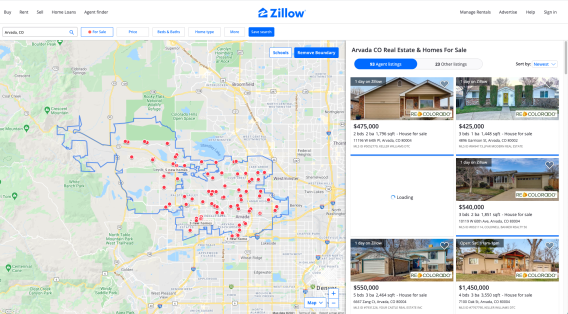
How do these changes affect the everyday life of the individual? There are more than 2 million active real estate agents in the United States. Their work has changed profoundly as they adapt real-estate-oriented websites and apps in their work. Even though most real estate agents work through local real estate firms, to a large degree they act largely as independent, small businesspeople who carry out much of their work from their cars and homes, as much as from their offices. So, they rely on websites and apps not only for information about individual homes, but also for lead generation, comparative market analysis, customer relationship management, tracking their business expenses such as mileage, access to virtual keys, video editing of listings, mounting marketing campaigns, and a multitude of other business functions. For those who are buyers and sellers, they can use Zillow or its online competitors to become informed buyers before ever meeting with a real estate agent, learning how much their current home is worth, figuring out how large a mortgage they can qualify for, checking out multiple potential neighborhoods not only for housing prices but also for quality of schools and crime rates, checking out photos and details of numerous candidate houses, and estimating the total cost of home ownership. Interestingly, many individuals who are not looking to buy or sell a home in the near term are regular users of Zillow. It is a way to spy on neighbors, try out possible selves, plan for one’s future, or just have a good time. In our introductory chapter, we address these issues.
Another chapter, by Philip Doty, reflects upon the American dream of the smart home. Drawing upon the scholarship in surveillance capitalism Soshanna Zuboff (2019), feminist scholarship on privacy, Anita Allen (1988), Patricia Bolling (1996), Catherine MacKinnon (1987), gender studies in history of science and technology, Ruth Cowan (1983), geography of surveillance, Lisa Makinen (2016), and other scholarly approaches, Doty reflects on the rhetorical claims about technological enthusiasm related to smart cities and smart homes, and discusses some of the privacy and in particular surveillance issues that arise in smart homes.
Information is not merely used by people in cognitive ways; it can also bring joy, sadness, anxiety, and an array of other emotions. Deciding where to live can be an exciting, fraught, and stressful experience for many people. When one is searching for a home in a particularly competitive housing market, the addition of time pressures can amp up the emotional toll of house hunting and discourage even the most excited home buyer. In her chapter, Carol Landry recounts how the high stakes decision making of home buying becomes even more complicated when time pressure and emotions come into play. Her research is based on an empirical study of home buyers in the highly competitive Seattle real estate market. The chapter describes the experience of several home buyers dealing with bidding wars that required quick decision making and many failed attempts at securing a home. The stories shared in this chapter highlight the despair and heartbreak that made continuing the home search difficult to participants described as going from enthusiastic information seekers to worn out information avoiders. This chapter highlights how internal and external factors can impact the home buying process and the information behaviors associated with it.
A competitive real estate market is but one of myriad experiences that can further complicate the process of deciding where to live. There are times in most people’s lives where the unique attributes of a life stage play an outsized role in decision-making around housing; one of these times is retirement. In Aspray’s chapter, the realities of retirement complicate the lives of individuals lucky enough to be able to retire with new considerations that shape decision making. Retirement adds new complexity to deciding where to live because the stability of work that binds many people’s lives is no longer there, creating many exciting new opportunities and constraints. Different elements shape questions around where to live for retired people including the emotional ties to their current homes, the financial realities of retirement income, and the physical limitations of aging.

During times of societal uncertainty, a home can be a comforting shelter that keeps the external world at bay. Even when a lot of uncertainty stems from the housing market, as it did during the Housing Crisis of 2007 and the recession that followed. As more and more people lost their homes to foreclosures or struggled to pay their mortgages, home and garden entertainment media provided a pleasant, comfortable escape for millions of Americans. Ocepek, in her chapter on home and garden sources, found that, throughout the housing crisis, recession, and recovery, home and garden sources grew or maintained their popularity with viewers and readers – likely due to the social phenomenon of cocooning or taking shelter in one’s space when the world outside becomes uncertain and scary. Both home and garden magazines and HGTV made changes to their content to represent the new home realities of many of their readers and viewers, but they also largely stayed the same, presenting comforting content about making whatever space you call home the most comfortable.
The financial hardships throughout the housing crisis, recession, and recovery were not experienced by all Americans in equal measure. Several authors in the book presented multiple examples where housing policies, economic conditions, and social unrest disproportionately affected marginalized communities throughout the United States. One is Pintar’s chapter about Milwaukee, mentioned below. Although some of the legal frameworks built to segregate cities and communities throughout the country have changed, the experience of deciding where to live for Black and African Americans adds additional layers of complexity to the already complicated process. Drawing on critical race theory, Jamillah Gabriel delineates how Black and African American house searchers (renters and buyers) create information seeking and search strategies to overcome the historic and contemporary discriminatory policies and practices of housing segregation. The chapter analyzes specialized information sources the provide useful information to help this group of house searchers find safer communities where they have the greatest chance to prosper. These sources include lists of the best and worst places for African American and Black individuals and families to live. The lists draw on research the compares communities based on schools, employment, entertainment, cost of living, housing market, quality of life, and diversity. Drawing on historic and contemporary account, the analysis provided in this chapter highlights that, “the housing industry can be a field of land mines for African American in search of home” (Gabriel 2021, p. 274).
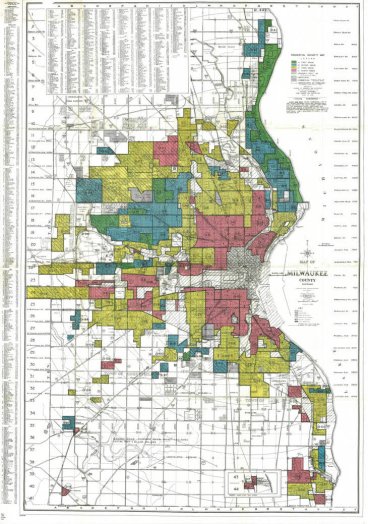
It is often said that information and information tools are neither inherently good or bad, but that they can be used for both good and bad purposes. Two chapters in the book illustrate this point. In a study of the city of Milwaukee, Judith Pintar shows how HOLC maps, which were created to assess the stability of neighborhoods, were used to reinforce the racist practice of redlining. In another chapter, by Hannah Weber, Vaughan Nagy, Janghee Cho, and William Aspray, the authors show how information tools were used by the city of Arvada, Colorado and various groups (such as builders, realtors, parents, activists, and the town council) to improve the city’s quality of life in the face of rapid growth and its attendant issues such as traffic problems, rising housing prices, the need to build on polluted land, and the desire to protect the traditional look and feel of this small town. A third chapter, by David Hopping, showed how an experiment in Illinois was able to repurpose military housing for non-military purposes for the social good. His empirical study is seen through the lens of the theoretical constructs of heterotopia (Foucault 1970), boundary objects (Star and Griesmer 1989), and pattern language (Alexander 1977).
Conclusions
Both of us are continuing to pursue work on everyday information issues. One (Aspray) is continuing this work on information studies in everyday life, through an edited book currently in progress on information issues related to older Americans (Aspray, forthcoming in 2022). This book ranges from traditional Library and Information Science approaches about health information literacy on insurance for older Americans, the variety of information provided by AARP and its competitors, and the use of information and communication technologies to improve life in elderly communities; to more technologically oriented studies on ubiquitous computing, human-computer interaction, and Internet of Things for older people. Meanwhile, Ocepek is building on her work in her doctoral dissertation (Ocepek 2016), which examined from both social science and cultural approaches the everyday activity of grocery shopping. Her new study is examining what has happened to grocery shopping during the pandemic.
We are pleased to see the broadening in mission of the Babbage Institute to consider not only the history of computing but also the history and cultural study of information. For example, many scholars (including some computer historians) since 2016 have been studying misinformation. (See, for example, Cortada and Aspray 2019; Aspray and Cortada 2019.) This study of everyday information is another way in which the Babbage Institute can carry out its broadened mission today.
In particular, there are a few lessons for computer historians that can be drawn from the scholarship we have discussed here, although many readers of this journal may already be familiar with and practicing them:
- One can study information as well as information technology. On the history of information, see for example Blair (2010), Headrick (2000), Cortada, (2016), and Ann Blair et al. (2021). For a review of this scholarship, see Aspray (2015).
- One can study everyday uses of information and information technology, even if they may be regarded by some as quotidian – expensive, complex, socially critical systems are not the only kinds of topics involving information technology that are worth studying.
- This past year has taught all of us how an exogenous force, the COVID-19 pandemic, can quickly and radically reshape our everyday lives. In the opening chapter of our book, we briefly discuss the earliest changes the pandemic brought to real estate. We are also seeing the grocery industry as well as the millions of consumers learning, adapting, and changing their information behaviors around safely acquiring food.
- In order to study both historical and contemporary issues about information and information technology, one can blend historical methods with other methods from computer science (e.g., human-computer interaction, data science), social science (qualitative and quantitative approaches from sociology, psychology, economics, and geography), applied social science (labor studies, management and organization studies), and the humanities disciplines (cultural studies, critical theory).
These are exciting times for the historians of computing and information!
Bibliography
Agosto, Denise E. and Sandra Hughes-Hassell. (2005). "People, places, and Questions: An Investigation of the Everyday Life Information-Seeking Behaviors of Urban Young Adults." Library & Information Science Research, vol. 27, no. 2, pp. 141-163.
Alexander, Christopher. (1977). A Pattern Language. Oxford University Press.
Allen, Anita L. (1988). Uneasy Access: Privacy for Women in a Free Society. Rowman & Littlefield.
Aspray, William. (2015). The Many Histories of Information. Information & Culture, 50.1: 1-23.
Aspray, William. (forthcoming 2022). Information Issues for Older Americans. Rowman & Littlefield.
Aspray, William and James Cortada. (2019). From Urban Legends to Political Factchecking. Springer.
Aspray, William and Barbara M. Hayes. (2011). Everyday Information. MIT Press.
Aspray, William, George W. Royer, and Melissa G. Ocepek. (2013). Food in the Internet Age. Springer.
Aspray, William, George W. Royer, and Melissa G. Ocepek. (2014). Formal and Informal Approaches to Food Policy. Springer.
Bakardjieva, Maria. (2005). Internet Society: The Internet in Everyday Life. Sage.
Blair, Ann. (2010). Too Much to Know. Yale.
Blair, Ann, Paul Duguid, Anja Silvia-Goeing, and Anthony Grafton, eds. (2021). Information: A Historical Companion. Princeton.
Boling, Patricia. (1996). Privacy and the Politics of Intimate Life. Cornell University Press.
Case, Donald O. and Lisa M. Given. (2016). Looking for Information. 4th ed. Emerald.
Cortada, James and William Aspray. (2019). Fake News Nation. Rowman & Littlefield.
Cowan, Ruth Schwartz. (1983). More Work for Mother. Basic Books.
De Certeau, Michel (1984). The Practice of Everyday Life. Translated by Steven F. Rendall. University of California Press.
Fisher, Karen E. Sandra Erdelez, and Lynne McKechnie. (2009). Theories of Information Behavior. Information Today.
Foucault, Michel. (1970). The Order of Things. Routledge.
Gorichanaz, Tim (2020). Information Experience in Theory and Design. Emerald Publishing.
Hartel, Jenna. (2003). "The Serious Leisure Frontier in Library and Information Science: Hobby Domains." Knowledge Organization, vol. 30, No. 3-4, pp. 228-238.
Haythornthwaite, Caroline and Barry Wellman, eds. (2002). The Internet in Everyday Life. Wiley-Blackwell.
Headrick, Daniel. (2000). When Information Came of Age. Oxford.
Highmore, Ben ed. (2001). The Everyday Life Reader. Routledge.
Lefebvre, Henri. (2008). Critique of Everyday Life. vol. 1, 2nd ed. Translated by John Moore. Verso.
MacKinnon, Catherine. (1987). Feminism Unmodified. Harvard University Press.
Makinen, Lisa A. (2016). "Surveillance On/Off: Examining Home Surveillance Systems from the User’s Perspective." Surveillance & Society, 14.
McKenzie, Pamela J. (2003). "A Model of Information Practices in Accounts of Everyday‐Life Information Seeking." Journal of Documentation, vol. 59, no. 1, pp. 19-40.
Pettigrew, Karen E. (1999). "Waiting for Chiropody: Contextual Results from an Ethnographic Study of the Information Behaviour Among Attendees at Community Clinics." Information Processing & Management. vol. 35, no. 6, pp. 801-817.
Ocepek, Melissa G. (2016). "Everyday Shopping: An Exploration of the Information Behaviors of the Grocery Shoppers." Ph.D Dissertation, School. Of Information, University of Texas at Austin.
Ocepek, Melissa G. and William Aspray, eds. (2021). Deciding Where to Live. Rowman & Littlefield.
Savolainen, Reijo. (2008). Everyday Information Practices: A Social Phenomenological Perspective. Scarecrow Press.
Smith, Dorothy E. (1987). The Everyday World as Problematic: A Feminist Sociology. Northeastern University Press.
Star, Susan Leigh and James R. Griesemer. (1989). "Institutional Ecology, Translations, and Boundary Objects: Amateurs and Professionals in Berkeley’s Museum of Vertebrate Zoology, 1907-39." Social Studies of Science 19, 3: 387-420.
Steedman, Carolyn. (1987). Landscape for a Good Woman: A Story of Two Lives. Rutgers University Press.
Yost, Jeffrey R. (2008). “Internet Challenges for Nonmedia Industries, Firms, and Workers.” pp. 315-350 in William Aspray and Paul Ceruzzi, eds., The Internet and American Business. MIT Press.
Zuboff, Shoshanna. (2019). The Age of Surveillance Capitalism. Public Affairs.
Aspray, William and Ocepek, Melissa G. (April 2021). “Everyday Information Studies: The Case of Deciding Where to Live." Interfaces: Essays and Reviews in Computing and Culture Vol. 2, Charles Babbage Institute, University of Minnesota, 27-37.
About the authors:
Melissa G. Ocepek is an Assistant Professor at the University of Illinois Urbana-Champaign in the School of Information Sciences. Her research draws on ethnographic methods and institutional ethnography to explore how individuals use information in their everyday lives. Her research interests include everyday information behavior, critical theory, and food. Recently, she co-edited Deciding Where to Live (Rowman & Littlefield, 2021) with William Aspray. Previously she published two books that address the intersection of food, information, and culture: Food in the Internet Age and Formal and Informal Approaches to Food Policy (both with William Aspray and George Royer). Dr. Ocepek received her Ph.D. at the University of Texas at Austin in the School of Information.
William Aspray is Senior Research Fellow at CBI. He formerly taught in the information schools at Indiana, Texas, and Colorado; and served as a senior administrator at CBI, the IEEE History Center, and Computing Research Association. He is the co-editor with Melissa Ocepek of Deciding Where to Live (Rowman & Littlefield, 2021). Other recent publications include Computing and the National Science Foundation (ACM Books, 2019, with Peter Freeman and W. Richards Adrion); and Fake News Nation and From Urban Legends to Political Fact-Checking (both with James Cortada in 2019, published by Rowman & Littlefield and Springer, respectively).
Of Mice and Mentalité: PARC Ways to Exploring HCI, AI, Augmentation and Symbiosis, and Categorization and Control
Jeffrey R. Yost, Charles Babbage Institute, University of Minnesota
Abstract: This think piece essay comparatively explores history and mindsets with human-computer interaction (HCI) and artificial intelligence (AI)/Machine Learning (ML). It draws on oral history and archival and other research to reflect on the institutional, and cultural and intellectual history of HCI (especially the Card, Moran, and Newell team at Xerox PARC) and AI. It posits the HCI mindset (focused on augmentation and human-machine symbiosis, as well iterative maintenance) could be a useful framing to rethink dominant design and operational paradigms in AI/ML that commonly spawn, reinforce, and accelerate algorithmic biases and societal inequality.

This essay briefly recounts the 1982 professional organizational founding for the field of Human-Computer Interaction (HCI) before reflecting on two decades prior in interactive computing—HCI’s prehistory/early history—and its trajectory since. It comparatively explores history and mindsets with HCI and artificial intelligence (AI). For both HCI and AI, “knowing users” is a common target, but also a point of divergent departure.
For AI—especially large-scale, deployed systems in defense, search, and social networking—knowing users tends to involve surveillance, data collection, and analytics to categorize and control in the service of capital and power. Even when aims are purer, algorithmic biases frequently extend from societal biases. Machines can be programed to discriminate or learn it from data and data practices.
For HCI—from idealistic 1960s beginnings through 1980s professionalization and beyond—augmenting users and human-machine symbiosis has been its core. While an HCI-type mindset offers no magic bullet to AI’s ills, this essay posits that it can be a useful framing, a reminder toward proper maintenance, stewardship, and structuring of data, design, code (software), and codes (legal, policy, and cultural). HCI systems, of course, can be ill designed, perform in unforeseen ways, or users can misapply them, but this likely is less common and certainly is of lesser impactful scale relative to AI. Historians and sociologists must research the vast topics of AI and HCI more fully in many contexts and settings.
HCI and Solidifying the Spirit of Gaithersburg
In mid-March 1982 IIT Programming Technology Center’s Bill Curtis and University of Maryland’s Ben Shneiderman held the first “Human Factors in Computing Systems” conference in Gaithersburg, Maryland. The inspiring event far exceeded the organizers’ expectations, attracting more than 900 attendees. It was the pivotal leap forward in professionalizing HCI.
Rich program content filled the three-day program, as impactful organizational work occurred at an evening, small group side meeting. At the latter, Shneiderman, Curtis, UCSD’s Don Norman, Honeywell’s Susan Dray, Northwestern’s Loraine Borman, Xerox PARC's (Palo Alto Research Center) Stuart Card and Tom Moran, and others strategized about HCI’s future and possibilities for forming an association within a parent organization. Borman, an information retrieval specialist in a leadership role at ACM SIGSOC (Social and Behavioral Computing), and Shneiderman, a computer scientist, favored the Association for Computing Machinery (ACM). Insightfully seeing an expedient workaround, Borman proposed SIGSOC transform—new name/mission—bypassing the need for a new SIG approval.
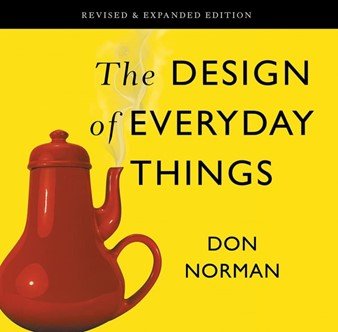
Cognitive scientist Don Norman questioned whether ACM should be the home, believing computer science (CS) might dominate. After debate, Shneiderman and Borman’s idea prevailed. Dray recalls, the sentiment was “we can’t let the spirit of Gaithersburg die,” and for most, SIGSOC’s metamorphous seemed a good strategy (Dray 2020). Borman orchestrated transforming SIGSOC into SIGCHI (Computer-Human Interaction). The CHI tail essentially became the dog (SOC’s shrinking base mainly fit under HCI’s umbrella). Interestingly, “Computer” comes first in the acronym, but likely just to achieve a pronounceable word in the ACM SIG style, as “HCI” appeared widely in early CHI papers (SIGCHI’s annual conference).
Norman’s concerns proved prescient. SIGCHI steadily grew reaching over 2,000 attendees by the 1990 Seattle CHI, but in its first decade, it principally furthered CS research and researchers. Scholarly standards rose, acceptance rates fell, and some practitioners felt crowded out. In 1991, practitioners formed their own society, User Experience Professional Association (UXPA). In the 1990s and beyond, SIGCHI blossomed into an increasingly (academic) discipline diverse organization.
As with all fields/subfields, HCI has a prehistory or an earlier less organizationally defined history (for HCI, the 1960s and 1970s). SIGCHI’s origin lay in the confluence of: past work in human factors; university “centers of excellence” in interactive computing created through 1960s Advanced Research Projects Agency (ARPA) Information Processing Techniques Office (IPTO) support; two particularly impactful laboratories (PARC and SRI’s ARC); Systems Group artists in the UK; and the promise of Graphical User Interface (GUI) personal computers (PCs).
Nonprofit corporation SRI’s Augmentation Research Center (ARC), and Xerox’s PARC were at the forefront of GUI and computer mouse developments in the 1970s and 1980s. Neither the GUI nor mouse R&D were secret at PARC; in the 1970s, many visitors saw Alto demos, including, in 1979, Steve Jobs/Apple Computer team. In 1980 Apple hired away PARC’s Larry Tesler and others. Jobs launched the Apple Lisa effort (completed in 1983, priced at $10,000), which like the even more expensive Xerox Star (1981), possessed a GUI and mouse. The 1984 Apple Macintosh, retailing at $2,500, initiated an early mass market for GUI personal computers—inspiring initiators, most notably, Microsoft Windows 2.0 in 1987.
In early 2020, I conducted in-person oral history interviews with three of HCI’s foremost intellectual and organizational pioneers—the pilot for a continuing ACM/CBI project. This included UCSD Professor Don Norman (SIGCH Lifetime Research Awardee; Benjamin Franklin Medalist), Xerox PARC Scientist and Stanford Professor Stuart Card (SIGCHI Lifetime Research Awardee; National Academy of Engineering), and Dr. Susan Dray (SIGCHI Lifetime Practice Awardee; UXPA Lifetime Achievement Awardee).
Don Norman is well-known both within and outside CS—extending from his 1988 book The Psychology of Everyday Things (POET), re-released as wide selling, The Design of Everyday Things. A student of Duncan Luce (University of Pennsylvania), he was among the first doctorates in mathematical psychology. Early in his career, he joined the UCSD Psychology Department as an associate professor. After stints at Apple and Hewlett-Packard, and at Northwestern, he returned to lead the UCSD Design Laboratory. Norman helped take design from its hallowed ground of aesthetics to establish it in science, and greatly advanced understanding and practice of usability engineering.

Norman stressed to me that there is one scientist so consistently insightful he never misses his talks at events he attends, PARC’s Stuart Card. Card was the top doctoral student of Carnegie Mellon Professor of Cognitive Psychology and Computer Science Allen Newell. While these two interviews were in California, my interview with Dr. Susan Dray was in Minneapolis, with the scientist who pioneered the first corporate usability laboratory outside the computer industry (IBM and DEC had ones) at American Express Financial Advisors (AEFA).
Dray took a different path after her doctorate in psychology from UCLA—human factors—on classified Honeywell Department of Defense (DoD) projects. In the early 1980s, Honeywell, a pioneering firm in control systems, computers, and defense-contracting, had a problem with ill-adapted computing in its headquarters for clerical staff, which Dray evaluated. This became path defining for her career, toward computer usability. After pioneering HCI work at Honeywell, Dray left for American Express, and later became a successful and impactful HCI consultant/entrepreneur. She applied observations, ethnographic interviewing, and the science of design to improve interaction, processes, and human-machine symbiosis in cultures globally, from the U.S., South Africa, Egypt and Jordan to India, Panama, and France.
Earlier, in the late 1980s, at American Express, Dray was seeking funds for a usability lab, and she creatively engaged in surreptitious user feedback. She bought a “carton” of Don Norman’s POET book, had copies delivered to all AEFA senior executives on the top/29th floor, and rode up and down the elevator starting at 6 am for a couple hours each morning for weeks, listening to conversations concerning this mysteriously distributed book on the science of design. Well-informed, she pitched successfully, gaining approval for her usability lab.
The Norman, Card, and Dray oral histories, another HCI interview I just conducted, with artist Dr. Ernest Edmonds, my prior interview with Turing Awardee Butler Lampson of Alto fame, preparation for these five interviews, and AI and HCI research at the CBI, MIT, and Stanford University archives inform this essay.
For AI and HCI, Is There a Season?
Microsoft Research Senior Scientist, Jonathan Grudin—in his valuable From Tool to Partner (2017) on HCI’s history—includes a provocative argument that HCI thrives during AI Winters and suffers during AI’s other seasons. The usefulness of the widespread Winter metaphor is debatable, it is based on changing funding levels to elite schools (Mendon-Plasek, 2021 p. 55), but Grudin’s larger point—only one of the two fields thrives at a time—hints to a larger truth: HCI and AI have major differences. The fields overlap with some scientists and some common work but have distinct mindsets. Ironically, AI, once believed to be long on promises and short on deliveries (the rationalized basis for AI Winters), is now delivering stronger, and likely, more harmfully than ever given algorithmic and data biases in far reaching corporate and government systems.
Learning How Machines Learn Bias
Increasingly more and more of our devices are “smart,” a distracting euphemism obscuring how AI (in ever-increasingly interconnected sensor/IoT/cloud/analytics systems) reinforces and extends biases based on race, ethnicity, gender, sexuality, and disability. Recent interdisciplinary scholarship is exposing roots of discriminatory code (algorithms/software) and codes (laws, policy, culture), including deeply insightful keynotes at the Charles Babbage Institute’s (CBI) “Just Code” Symposium (a virtual, major event with 345 attendees in October 2020) by Stephanie Dick, Ya-Wen Lei, Kenneth Lipartito, Josh Lauer, and Theodora Dryer. Their work contributes to an important conversation also extended in important scholarship by Ruha Benjamin, Safiya Noble, Matt Jones, Charlton McIlwain, Danielle Allen, Jennifer Light (MIT; and CBI Sr. Research Fellow), Mar Hicks, Virginia Eubanks, Lauren Klein, Catherine D’Ignazio, Amanda Menking, Aaron Mendon-Plasek (Columbia; and current CBI Tomash Fellow), and others.
AI did not merely evolve from a benevolent past to a malevolent present. Rather, it has been used for a range of different purposes at different times. Geometrically expanding the number of transistors on chips—the (partially) manufactured and manufacturing/fabrication trajectory of Moore’s Law—enabled computers and AI to become increasingly powerful and pervasive. Jennifer Light’s insightful scholarship on the RAND Corporation’s 1950s and 1960s operations research, systems engineering, and AI, created in the defense community, and later misapplied to social welfare, counters notions of an early benevolent age. Even if chess is the drosophila of AI—a phrase of John McCarthy’s from the 1990s—its six-decade history is one of consequential games, power contests. Work in computer rooms at the Pentagon’s basement and at RAND harmfully escalated Cold War policies as DoD/contractors simulated and supported notions of the U.S. rapidly “winning” the Vietnam War, and earlier, C-E-I-R (founded by ex-RAND scientists) used input/output-economics algorithmic systems to determine optimal bomb targets to decimate the Soviet Union industrially (Yost, 2017).
What helped pulled AI out of its first long (1970s) Winter was successes and momentum with expert systems—the pioneering work of Turing Awardee Stanford AI scientist Edward Feigenbaum and molecular biologist and Nobel Laureate Joshua Lederberg’s late 1960s Dendral, to advance organic chemistry, and Feigenbaum and others’ early 1970s MYCIN in medical diagnostics and therapeutics. These AI scientific triumphs stood out and lent momentum for expert systems, as did fears of Japan’s Fifth Generation (early 1980s—government and industry partnership in AI/systems). In the 1980s, elite US CS departments again received strong federal support for AI. Work in expert systems in science, medicine, warfare, and computer intrusion detection abounded (Yost, 2016).
Some AI systems are born biased; others learn it—from algorithmic tweaks to expert system inference engines to biased data. Algorithmic bias is just one of the many problematic byproducts of valuing innovation over maintenance (Vinsel and Russell 2020, Yost 2017).
Human Factors and Ergonomics
The pre-history/early history of human-machine interaction dates back many decades to the control of workers and soldiers to maximize efficiency. The late-1950s-spawned Human Factors Engineering Society grew out late inter-war period organizational work of the Southern California aerospace industry. In the first half of the 20th century, human factors had meaningful roots in the scientific management thought, writings, and consulting of Frederick Winslow Taylor. This tradition defined the worker as an interchangeable part, a cog within the forces of production to efficiently serve capital. At Taylorist-inspired and organized factories, management oppressed laborers, and human factors has a mixed record in its targets, ethics, and outcomes. However, in HCI’s organizational start, early 1980s, the mantra was not merely of efficiency; it was the frequently uttered, “know the user.” This, importantly, was a setting of personal computing and GUI idealism, a trajectory insightfully explored by Stanford’s Fred Turner in From Counterculture to Cyberculture.

We’re on a Road to Intertwingularity, Come on Inside
Years before the National Science Foundation (NSF) took the baton to be the leading federal funder of basic CS research at universities, ARPA’s IPTO (following 1962 founding director’s J.C.R. Licklider’s vision), changed the face of computing toward interaction. Well known philosopher and sociologist Ted Nelson, a significant HCI contributor of the 1960s and 1970s, creatively coined the term “intertwingularity” of the symbiosis and all being intertwined or connected (networking, text through his term/concept of “hypertext,” human user with interactive computing)—it can aptly describe the multifaceted HCI work of 1960’s IPTO-funded SRI’s ARC and 1970s Xerox PARC.
The 1970-enacted Mansfield Amendment required direct and defined DoD function for all DoD research funding. It left a federal funding vacuum for years until NSF could ramp up to become a roughly comparable basic funder for the interactive computing that IPTO started. The vacuum, however, was largely filled by a short golden age of corporate industrial research in interactive computing at Xerox, a firm with a capital war chest, much dry powder, from its past photocopier patent-based monopoly, and seeking to develop the new, new thing(s). Xerox looked to its 1970-launched PARC to invent the office of the future. It hired many previously IPTO-supported academic computer scientists, it produced and employed a cadre of Turing Awardees, an unprecedented team far exceeding any single university’s CS department in talent or resources.
Inside the PARC Homeruns
Douglas Engelbart and the earliest work on the first mouse designed by him and SRI’s Bill English is addressed by French Sociologist Thierry Bardini in Bootstrapping, a biography of Engelbart. Journalists, such as Michael Hiltzik, have covered some major contours of technical innovation at PARC.
Central to Bardini’s and Hiltzik’s and others’ narratives is the important HCI work of Turing Awardees Douglas Engelbart at SRI; and Butler Lampson, Alan Kay, Charles Thacker, and Charles Simonyi at PARC. In this essay I look beyond oft-told stories and famed historical actors in GUIs and mice to briefly discuss a hitherto largely overlooked, highly impressive small PARC research team composed of Newell, Card, and Moran, and a larger team that Card later led. The incredible accomplishments of Lampson and others changed the world with the GUI. They hit the ball out park, so to speak—"a shot heard round the world” (1951 Bobby Thompson Polo Grounds, Don DeLillo immortalized, homerun sense) that very visibly revolutionized interactive computing
Newell is one of the most famous of the first-generation AI scientists, a principal figure at John McCarthy’s famed Dartmouth Summer 1956 Workshop, in which McCarthy, Newell, Herbert Simon, Marvin Minsky, and others founded and gave name to the field—building upon earlier work of Alan Turing. On a project launched in 1955, Newell, as lead, co-invented (with Simon and Clifford Shaw) “The Logic Theorist” in 1956, the first engineered, automated logic or AI program. Many historian and STS colleagues I have spoken with associate Newell solely with AI, and they are unaware of his PARC HCI work. Unlike Turing and Simon, Newell does not have a major biography documenting the full breadth of his work. Newell’s HCI research has been neglected by historians, as has that of his two top students, Card and Moran. They published many seminal HCI papers in Communications of the ACM and other top journals.
This oversight (by historians, they were revered by fellow scientists), especially neglecting career long contributions of Card and Moran, is a myopic favoring of first-recognized invention over subsequent ones, missing key innovations, and devaluing maintenance. It was not merely the dormouse (mouse co-inventors Engelbart and English, the recognized revolution), but multiple dormice (the science and engineering behind optimizing mice for users). Remember(ing) what the dormice said (and with an open ear of historical research), Card and Moran clearly conducted brilliant scientific research spawning many quiet revolutions.

Rookie Card to All-Star Card, Pioneering HCI Scientist Stuart Card
Stuart Card was first author of a classic textbook, Psychology of Human-Computer Interaction, with co-authors Newell and Moran. Card progressed through various research staff grades and in 1986 became a PARC Senior Research Scientist. Two years later, he became Team Leader of PARC’s User Interface Research Group. The breadth and contributions of Card and PARC’s HCI research in the 1970s to 1990s is wide in both theory and practice. The work fell into three broad categories: HCI Models, Information Visualization, and Information Retrieval—and major contributions in each is breathtaking. One early contribution in HCI models was Card and the team’s work on the mouse and its performance by an information-theoretical model of motor movement, Fitts’ Law, using a processing rate parameter of 10 bits/sec, roughly at the same performance ability as the hand, demonstrating performance was not limited by the device/mouse in terms of speed, but by the hand itself. It proved a mouse was optimized to interact with humans. This impacted the development of the Xerox Star mouse in 1981 and the earliest computer mice developed by Apple Computer. Card’s, and his team’s, work was equally profound on information visualization, in areas such as Attentive-Reactive Visualizer and Visualizer Transfer Functions. In information retrieval, they did advanced Information Foraging Theory.
While staying at PARC for decades, Card concurrently served as a Stanford University Professor of Computer Science. He became a central contributor to SIGCHI and was tremendously influential to academic, industrial, and government scientists.
In listening to Card’s interview responses (and deeply influenced by my Norman, Dray, and Butler Lampson interviews also, as well as by my past research), I reflected that many AI scientists could learn much from such a mindset of valuing users, all users—knowing users to help augment, for symbiosis, not to control. AI scientists, especially on large scale systems in corporations and government (much ethical AI research is done at universities), could benefit in not merely technical ways, as Steve Jobs and others did from their day in the PARC, but from Card and his team’s ethos and ethics.
Professionalizing HCI: Latent Locomotion to Blissful Brownian Motion
While SIGCHI unintentionally pushed out many non-scientists in the 1980s, it and the HCI field shed strictly a computer science and cognitive science focus to become ever more inclusive of a wide variety of academic scientists, engineers, social scientists, humanities scholars, artists, and others from the 1990s forward. CHI grew from about 1,000 at the first events in Gaithersburg and Boston to more than 3,600 attendees at some recent annual CHI meetings (and SIGCHI now has more than two-dozen smaller conferences annually). The SIGCHI/CHI programs and researchers are constantly evolving and exploring varying creative paths that from a 30,000-foot vantage might seem to be many random walks, Brownian motion. The research, designing to better serve users, contributes to many important trajectories. The diversity of disciplines and approaches can make communication more challenging, but also more rewarding, and to a high degree a Galison-like trading zone exist in interdisciplinary SIGCHI and HCI.
One example is the Creativity and Cognition Conference co-founded by artists/HCI scientists Ernest Edmonds and Linda Candy in 1993 that became a SIGCHI event in 1997. It brings together artists, scientists, engineers, and social scientists to share research/work on human-computer interaction in art and systems design. As Edmonds related to me, communication and trust between artists and scientists takes time, but is immensely valuable. Edmonds is an unparalleled figure in computer generative and interactive art, and a core member of the Systems Group of principally UK computer generative artists. In addition to many prestigious art exhibitions in the 1970s (and beyond), Edmonds published on adaptive software development, with critique of the waterfall method. His work—in General Systems in 1974—anticipated and helped to define adaptive techniques, later referred to as agile development. Edmonds, through his artist, logician, and computer science lenses insightfully saw interactive and iterative processes, a new paradigm in programming technique, art, and other design.
HCI research, and its applications, certainly is not always in line with societal good, but it has an idealistic foundation and values diversity and interdisciplinarity. Historians still are in the early innings of HCI research. Elizabeth Petrick has done particularly insightful scholarship on HCI and disability (2015).
Coding and Codifying, Fast and Slow
Nobel Laureate Daniel Kahneman has published ideas on human cognition that are potentially useful to ponder with regard to AI and HCI. Kahneman studies decision-making, and judgement, and how different aspects of these arise from how we think—both fast, emotionally, unconsciously, and instinctively; and slow, more deeply and analytically.
Programming projects for applications and implementation of systems are often behind schedule and over-budget. Code, whether newly developed or recycled, often is applied without an ethical evaluation of its inherent biases.
HCI often involves multiple iterations with users, usability labs, observation in various settings, ethnographic interviewing, and an effective blend of both inspiring emotional-response, fast thinking, and especially, deep reflective slow thinking. This slow and analytical thinking and iterative programming (especially maintenance, and endless debugging) could potentially be helpful in beginning to uproot underlying algorithmic biases. Meanwhile, slow, and careful reflection on how IT laws, practices, policies, culture, and data are codified is instructive. All of this involves ethically interrogating the what, how, why, and by and for whom of innovation, and valuing maintenance labor and processes, not shortchanging maintenance in budget, respect, or compensation.
Beyond “Laws” to Local Knowledge
In 1967 computer scientist, Melvin Conway, noted (what became christened) Conway’s Law—computer architecture reflects the communication structure of the underlying organization where it was developed (made famous by Tracy Kidder’s The Soul of a New Machine). Like Moore’s Law, Conway’s Law is really an observation, and a self-fulfilling prophecy. Better understanding and combatting biases at the macro is critical. Also essential is evaluation and action at the local and organizational levels. How does organizational culture structure algorithms/code? What organizational policies give rise to what types of code? What do (end) users, including and especially marginalized individuals and groups, have to say on bias? How do decisions at the organizational level reinforce AI/ML algorithmic and data biases, and reinforce and accelerate societal inequality? These are vital questions to consider through many future detailed cases studies in settings globally. The goal should not be a new “law,” but rather a journey to gain local knowledge and learn how historical, anthropological, and sociological cases inform on code and codes toward policies, designs, maintenance, and structures that are more equitable.
“Why Not Phone Up Robinhood and Ask Him for Some Wealth Distribution”
The lyric above from the 1978 reggae song “White Man in a Hammersmith Palais,” by The Clash, might be updated to why not open a Robinhood app… (at least until it suspended trading). How historians later assess the so-called Robinhood/Reddit “Revolution” a transfer of $20 billion away from hedge funds/banks/asset managers over several weeks in early 2021 (punishing bearish GameStop shorting by bidding up shares to force short covering), remains to be seen. Is it a social movement, and of what demographic makeup and type? For many, it likely, at least in part, is a stand against Wall Street, and thus Zuccotti Park comparisons seem apropos. Eighty percent of stock trading volume is automated—algorithmic/programmed (AI/ML)—contributing to why a 2021 CNBC poll showed 64 percent of Americans believe Wall Street is rigged. Like capitalism, equities markets and computers combine as a potent wealth concentrating machine—one turbocharged in pandemic times and fueled by accommodative monetary policy. “Smart” systems/platforms in finance, education, health, and policing all accelerated longstanding wealth, health and incarceration gaps and divergences to hitherto unseen levels. Not to dismiss volatility or financial risk to the Reddit “revolutionaries,” but the swiftness of regulatory calls by powerful leaders is telling. It begs questions on priorities: regulation for who, of what, when, and why? U.S. IT giants using AI to surveille, and to dominate with anti-competitive practices has gone largely unregulated (as has fintech) for years. Given differential surveillance, Blacks, Indigenous, People of Color (BIPOC) suffer differentially. The U.S. woefully lags Europe on privacy protections and personal data corporate taxes. U.S. racial violence/murders by police disgracefully dwarfs other democratic nations, and America stands out for Its (police and courts) embracement of racially biased facial recognition technology (FRT) and recidivist predictive AI—such as Clearview FRT and Northpointe’s (now Equivant) Corrective Offender Management Profiling for Alternative Sanctions (COMPAS).
Meanwhile parallel Chinese IT giants Baidu, Alibaba, and Tencent, dominant in search, e-commerce, and social networking respectively, use intrusive AI. These firms (fostered by the government), ironically, are also contributing to platforms enabling a “contentious public sphere.” (Lei 2017).
At times, users can appropriate digital computing tools against the powerful in unforeseen ways. Such historical agency is critical to document and analyze. History informs us that AI/ML, like many technologies, left unchecked by laws, regulations, and ethical scrutiny will continue to be powerfully accelerating tools of oppression.
Raging Against Machines That Learn
U.S. headquartered AI-based IT corporate giants’ record on data and analytics policy and practices have garnered increasing levels of critique by journalists, academics, legislators, activists, and others. The New York Times has reported on clamp downs on employees expressing themselves on social and ethical issues. The co-leader of Google’s Ethical AI Group Timnit Gebru tweeted in late 2020 she was fired for sending an email encouraging minority hiring and drawing attention to bias in artificial intelligence. Her email included, “Your life starts getting worse when you start advocating for underrepresented people. You start making the other leaders upset.” (Metz and Wakabayashi 2020).
On June 30, 2020, U.S. Senators Robert Menendez, Mazie Hirono, and Mark Warner wrote Facebook CEO Mark Zuckerberg critiquing his company for failing to “rid itself of white supremacist and other extremist content.” (Durkee 2020). A subsequent Facebook internal audit called for better AI—a tech fix. Deep into 2019 Zuckerberg (with a lack of clarity, as at Georgetown in October 2019) sought to defend Facebook’s policies on the basis of free speech. More concerning than his inability to execute free speech arguments is the lack of transparency and the power wielded by a platform with 2.5 billion users, it has immense power to subvert democracy and to differentially harm. It has a clear record of profits over principles. In mid-2020 The Color of Change, NAACP, National Hispanic Media Coalition and others launched the “Stop Hate for Profit” boycott on Facebook advertising for July 2020, more than 1,200 organizations participated. Pivoting PR in changing political winds, Zuckerberg is seeking to shift responsibility to Congress asking it to regulate (Facebook’s legal team likely will defend the bottom line).
Data for Black Lives, led by Executive Director Yeshimabeit Milner, is an organization and movement of activists and mathematicians. It focuses on fighting for possibilities for data use to address societal problems and fighting against injustices, stressing “discrimination is a high-tech enterprise.” It recently launched, Abolish Big Data, “a call to action to reject the concentration of Big Data in the hands of the few, to challenge the structures that allow data to be wielded as a weapon…” (www.d4bl.org). This organization is an exemplar of vital work for change underway, and also of the immense challenge ahead given the power of corporations and government entities (NSA, CIA, FBI, DoD, police, courts).
HCI, never the concentrating force AI has become, continues to steadily grow as a field—intellectually, in diversity, and in importance. It has a record of embracing diversity, helping to augment and advance human and computer symbiosis. More historical work on HCI is needed, but it offers a useful mindset.
Given AI historical scholarship to date, we know its record has been mixed from the start. From its first decades of 1950s and 1960s to today, DoD, NSA/CIA/FBI, Police, and criminal justice have been frequent funders, deployers and users of AI systems plagued with algorithmic biases that discriminate against BIPOC, women, the LGBTQIA, and the disabled. Some of the most harmful systems have been with facial recognition and predictive policing. Yet, properly designed, monitored, and maintained, AI offers opportunities for science, medicine, and social services (especially at universities and nonprofits).
The social science, humanities, and arts can have a fundamental positive role on the design, structuring, and policies with AI/ML. A handful of universities recently have launched interdisciplinary centers to focus on AI, history, and society. This includes the recently formed AI Now Institute at NYU (2017) and the Institute for Human-Centered AI at Stanford (2019). The Charles Babbage Institute has made the interdisciplinary social study of AI and HCI a focus (with “Just Code” and beyond)—research, archives, events, oral histories, and publications. In CS, ACM’s (2018 launched) Conference on Fairness, Accountability, and Transparency (FAccT), offers a great forum. Outside academe many are doing crucial research, policy, and activist work—a few examples: Data for Black Lives; Blacks in Technology; NC-WIT; AnitaB.org; Algorithmic Justice League; Indigenous AI.Net; Algorithmic Bias Initiative, (U. of Chicago).
The lack of U.S. regulation to date, discrimination and bias, corporate focus and faith on tech fixes, inadequate transparency, corporate imperialism, and overpowering employees and competitors have many historical antecedents inside and outside computing. History—the social and policy history of AI and HCI, as well as other labor, race, class, gender, and disability history—has much to offer. It can be a critical part of a broad toolkit to understand, contextualize, and combat power imbalances—to better ensure just code and ethically shape and structure the ghost in the machine that learns.
Acknowledgments: Deep thanks to Bill Aspray, Gerardo Con Diaz, Andy Russell, Loren Terveen, Honghong Tinn, and Amanda Wick for commenting on a prior draft.
Bibliography
Allen, Danielle and Jennifer S. Light. (2015). From Voice to Influence: Understanding Citizenship in a Digital Age. University of Chicago Press.
Alexander, Jennifer. (2008). The Mantra of Efficiency: From Waterwheel to Social Control. Johns Hopkins University Press.
Bardini, Thierry. (2000). Bootstrapping: Coevolution and the Origins of Personal Computing. Stanford University Press.
Benjamin, Ruha. (2019). Race After Technology: Abolitionist Tools for the New Jim Code. Polity.
Card, Stuart K., Thomas Moran, and Allen Newell (1983). The Psychology of Human-Computer Interaction. Lawrence Erlbaum Associates.
Card, Stuart K., Oral History (2020). Conducted by Jeffrey R. Yost, Los Altos Hills, CA, February 17, 2020. CBI, UMN.
Dick, Stephanie. (2020). “NYSIIS, and the Introduction of Modern Digital Computing to American Policing.” Just Code: Power, Inequality, and the Global Political Economy of IT (Symposium presentation: Oct. 23). [Hereafter “Just Code” Symposium]
D’Ignazio, Catherine and Lauren Klien. (2020). Data Feminism. MIT Press.
Dray, Susan, Oral History (2020). Conducted by Jeffrey R. Yost, CBI, Minneapolis, Minnesota, January 28, 2020. CBI, UMN.
Durkee, Alison. (2020). “Democratic Senators Demand Facebook Answer For Its White Supremacist Problem.” Forbes. June 30. (accessed online at Forbes.com).
Dryer, Theodora. (2020). “Streams of Data, Streams of Water: Encoding Water Policy and Environmental Racism.” Just Code” Symposium.
Edmonds, Ernest. (1974). “A Process for the Development of Software for Non-Technical Users as an Adaptive System.” General Systems 19, 215-218.
Eubanks, Virginia. (2019). Automating Inequality: How High-Tech Tools Punish, Police, and Punish the Poor. Picador.
Galison, Peter. (1999) “Trading Zone: Coordinating Action and Belief.” In The Science Studies Reader, ed. by Mario Biagioli. Routledge. 137-160.
Grudin, Jonathan. (2017). From Tool to Partner: The Evolution in Human-Computer Interaction. Morgan and Claypool.
Hiltzik, Michael. (2009). Dealers in Lightening: Xerox PARC and the Dawn of the Computer Age. HarperCollins.
Kahnman, Daniel. (2011). Thinking, Fast and Slow. Farrar, Straus, and Giroux.
Kidder, Tracy. (1981). Soul of a New Machine. Little, Brown, and Company.
Lampson, Butler, Oral History (2014). Conducted by Jeffrey R Yost, Cambridge, Massachusetts, December 11, 2014. Charles Babbage Institute, UMN.
Lauer, Josh and Kenneth Lipartito. (2020) “Infrastructures of Extraction: Surveillance Technologies in the Modern Economy.” Just Code” Symposium.
Light, Jennifer S. (2005). From Warfare to Welfare: Defense Intellectuals and Urban Problems in Cold War America. University of Chicago Press.
McIlwain, Charlton. (2020). Black Software. The Internet and Racial Justice: From AfroNet to Black Lives Matter. Oxford University Press.
Mendon-Plasek, Aaron. (2021). “Mechanized Significance and Machine Learning: Why It Became Thinkable and Preferable to Teach Machines to Judge the World.” In J. Roberge and M. Castelle, eds. The Cultural Life of Machine Learning. Palgrave Macmillan, 31-78.
Menking, Amanda and Jon Rosenberg. (2020). “WP:NOT, WP:NPOV, and Other Stories Wikipedia Tells Us: A Feminist Critique of Wikipedia's Epistemology.” Science, Technology, & Human Values, May, 1-25.
Metz, Cade and Daisuke Wakabayashi. (2020). “Google Researcher Says She was Fired Over Paper Highlighting Bias in AI.” New York Times, Dec. 2, 2020.
Norman, Don, Oral History. (2020). Conducted by Jeffrey R. Yost, La Jolla, California, February 12, 2020. CBI, UMN.
Noble, Safiya Umoja. (2018). Algorithms of Oppression: How Search Engines Reinforce Racism. New York University Press.
Petrick, Elizabeth. (2015). Making Computers Accessible: Disability Rights and Digital Technology. Johns Hopkins University Press.
Turner, Fred. (2010). From Counterculture to Cyberculture: Stewart Brand, the Whole Earth Network, and the Rise of Digital Utopianism. University of Chicago Press.
Vinsel, Lee and Andrew L. Russell. (2020). The Innovation Delusion: How our Obsession with the New has Disrupted the Work That Matters Most. Currency.
Yost, Jeffrey R. (2016). “The March of IDES: Early History of Intrusion Detection Expert Systems.” IEEE Annals of the History of Computing 38:4, 42-54.
Yost, Jeffrey R. (2017). Making IT Work: A History of the Computer Services Industry. MIT Press.
Yost, Jeffrey R. (March 2021). “Of Mice and Mentalité: PARC Ways to Exploring HCI, AI, Augmentation and Symbiosis, and Categorization and Control". Interfaces: Essays and Reviews in Computing and Culture Vol. 2, Charles Babbage Institute, University of Minnesota, 12-26.
About the author: Jeffrey R. Yost is CBI Director and HSTM Research Professor at the University of Minnesota. He has published six books (and dozens of articles), most recently Making IT Work: A History of the Computer Services Industry (MIT Press, 2017) and FastLane: Managing Science in the Internet World (Johns Hopkins U. Press, 2016) [co-authored with Thomas J. Misa]. He is a past EIC of IEEE Annals of the History of Computing, and current Series Co-Editor [with Gerard Alberts] of Springer’s History of Computing Book Series. He has been a principal investigator of a half dozen federally sponsored projects (NSF and DOE) on computing/software history totaling more than $2 million. He is Co-Editor [with Amanda Wick] of Interfaces: Essays and Reviews in Computing & Culture.
The Cloud, the Civil War, and the “War on Coal”
Paul E. Ceruzzi, National Air and Space Museum, Smithsonian Institution
Abstract: The term “The Cloud” has entered the lexicon of computer-speak along with “cyberspace,” the Matrix,” the “ether,” and other terms suggesting the immateriality of networked computing. Cloud servers, which store vast amounts of data and software accessible via the Internet, are located around the globe. This essay argues that this “matrix” has an epicenter, namely the former rural village of Ashburn, Virginia. Ashburn’s significance is the result of several factors, including northern Virginia’s historic role in the creation of the Internet and its predecessor, the ARPANET. The Cloud servers located there also exist because of the availability of sources of electric power, including a grid of power lines connected to wind turbines, gas-, and coal-fired plants located to its west—a “networking” of a different type but just as important.
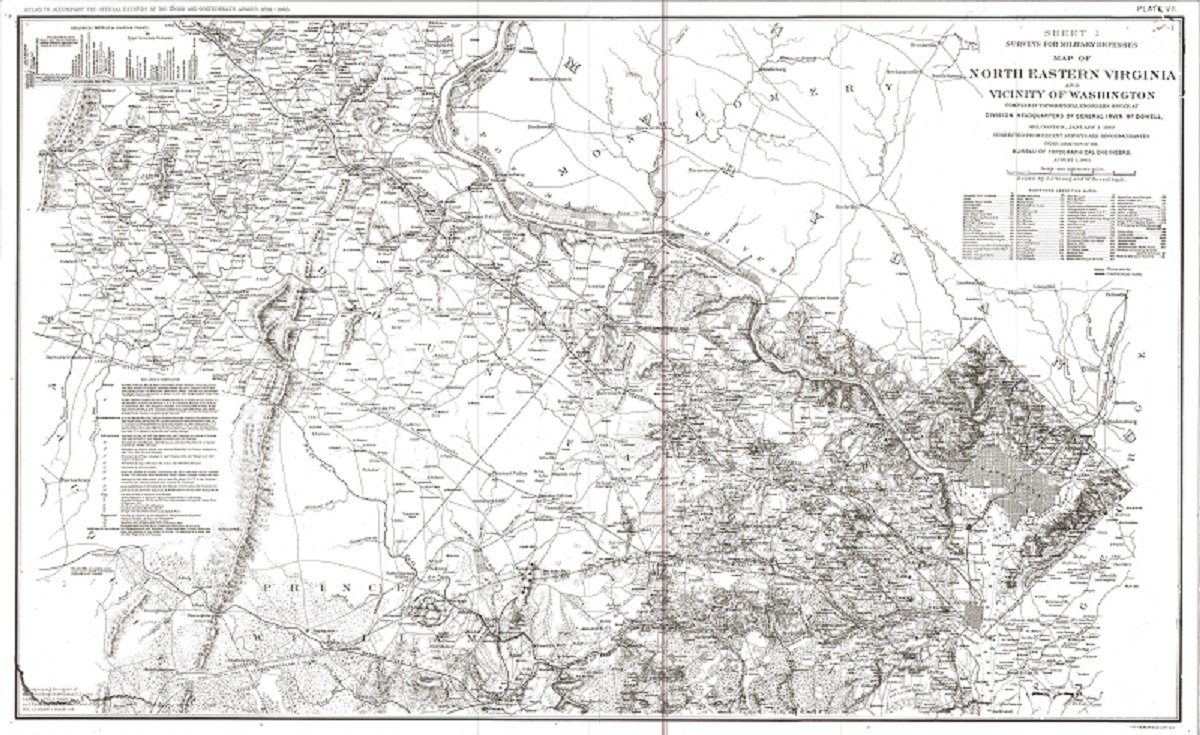
In In his recent book, Making IT Work, Jeffrey Yost quotes a line from the famous Joni Mitchell song, “Clouds”: “I really don’t know clouds at all.” He also quotes the Rolling Stones’ hit, “[Hey, you,] Get off my Cloud.” Why should a business or government agency trust its valuable data to a third-party, whose cloud servers are little understood? No thank you, said the Rolling Stones; not until you can explain to me just what the Cloud is and where it is. Yost gives an excellent account of how cloud servers have come to the fore in current computing. Yet Joni Mitchell’s words still ring true. Do we really know what constitutes the “Cloud”?
A common definition of the Cloud is that of sets of high-capacity servers, scattered across the globe, using high-speed fiber to connect the data stored therein to computing installations. These servers supply data and programs to a range of users, from mission-critical business customers to teenagers sharing photos on their smartphones. What about that definition is cloud-like? Our imperfect understanding of the term is related to the misunderstanding of similar terms also in common use. One is “cyberspace,” the popularity of which is attributed to the Science Fiction author William Gibson, from his novel Neuromancer, published in 1984. Another is “The Matrix”: the title of a path-breaking book on networking by John Quarterman, published in 1990 at the dawn of the networked age. The term came into common use after the award-winning 1999 Warner Brothers film starring Keanu Reeves. (Quarterman was flattered that Hollywood used the term, but he is not sure whether the producers of the film knew of his book.) In the early 1970s, Robert Metcalfe, David Boggs, and colleagues at the Xerox Palo Alto Research Center developed a local area networking system they called “Ethernet”: suggesting the “luminiferous aether” that was once believed to carry light through the cosmos.
These terms suggest an entity divorced from physical objects—pure software independent of underlying hardware. They imply that one may dismiss the hardware component as a given, just as we assume that fresh, drinkable water comes out of the tap when we are thirsty. The residents of Flint, Michigan know that assuming a robust water and sewerage infrastructure is hardly a given, and Nathan Ensmenger has reminded us that the “Cloud” requires a large investment in hardware, including banks of disk drives, air conditioning, fiber connections to the Internet, and above all, a supply of electricity. Yet the perception persists that the cloud, like cyberspace, is out there in the “ether.”

Most readers of this journal know the physical infrastructure that sustains Ethernet, Cyberspace, and the Cloud. I will go a step further: not only does the Cloud have a physical presence, but it also has a specific location on the globe: Ashburn, Virginia.
A map prepared by the Union Army in 1862 of Northern Virginia shows the village of Farmwell, and nearby Farmwell Station on the Alexandria, Loudoun, and Hampshire railroad. The town later changed its name to Ashburn, and it lies just to the north of Washington Dulles International Airport. In the early 2000s, as I was preparing my study of high technology in northern Virginia, Ashburn was still a farming community. Farmwell Station was by the year 2000 a modest center of Ashburn: a collection of buildings centered on a general store. The railroad had been abandoned in 1968 and was now the Washington and Old Dominion rail-trail, one of the most popular and heavily traveled rails-to-trails conversions in the country. Thirsty hikers and cyclists could get refreshment at the general store, which had also served neighboring farmers with equipment and supplies.

Cycling along the trail west of Route 28 in 2020, one saw a series of enormous low buildings, each larger than the size of a football field, and surrounded by a mad frenzy of construction, with heavy equipment trucks chewing up the local roads. Overhead was a tangle of high-tension electrical transmission towers, with large substations along the way distributing the power. The frenzy of construction suggested what it was like to have been in Virginia City, Nevada, after the discovery and extraction of the Comstock Lode silver. The buildings themselves had few or no markings on them, but a Google search revealed that one of the main tenants was Equinix, a company that specializes in networking. The tenants of the servers try to avoid publicity, but the local chambers of commerce, politicians, and real estate developers are proud to showcase the economic dynamo of the region. A piece on the local radio station WTOP on November 17, 2020, announced that “Equinix further expands its big Ashburn data center campus,” quoting a company spokesperson saying that “…its Ashburn campus is the densest interconnection hub in the United States.” An earlier broadcast on WTOP reported on the activities of a local real estate developer, that “Northern Virginia remains the ‘King of the Cloud’” In addition to Equinix, the report mentioned several other tenants, including Verizon and Amazon Web Services.
These news accounts are more than just hyperbole from local boosters. Other evidence that indicates that, although cloud servers are scattered across the globe, Ashburn is indeed the navel of the Internet.
In my 2008 study of Tysons Corner, Virginia, I mentioned several factors that led to the rise of what I then called “Internet Alley.” One was the development of ARPANET at the Pentagon, and later at a DARPA office on Wilson Blvd. in Rosslyn. Another was the rise of the proto-Internet company AOL, headquartered in Tysons Corner. Also, in Tysons Corner was the location of “MAE-East”—a network hub that carried a majority of Internet traffic in its early days. The root servers of the dot.com and dot.org registry were once located in the region, with the a: root server in Herndon, later moved to Loudoun County. The region thus had a skilled workforce of network-savvy electrical and computer engineers, plus local firms such as SAIC and Booz-Allen who supported networking as it evolved from its early incarnations.
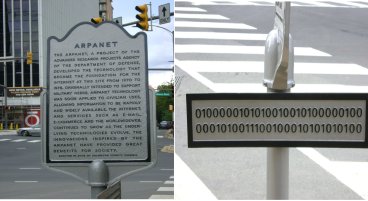
Around the year 2000, while many were relieved that the “Y2K” bug had little effect on mainframe computers, the dot.com frenzy collapsed. The AOL-Time Warner merger was a mistake. But there was an upside to the boom-and-bust. In the late 19th and early 20th Century the nation experienced a similar boom and bust of railroad construction. Railroads went bankrupt and people lost fortunes, But the activity left behind a robust, if overbuilt, network of railroads that served the nation well during the mid and late 20th century. During the dot.com frenzy, small firms like Metropolitan Fiber dug up many of the roads and streets of Fairfax and Loudoun Counties and laid fiber optic cables, which offered high speed Internet connections. After the bust these became unused— “dark fiber” as it was called. Here was the basis for establishing Cloud servers in Ashburn. By 2010, little land was available in Tysons Corner, Herndon, or Reston, but a little further out along the W&OD rail-trail was plenty of available land.
That leaves the other critical factor in establishing Cloud servers—the availability of electric power. While some Cloud servers are located near sources of wind, solar, or hydroelectric power, such as in the Pacific Northwest, Northern Virginia has few of those resources. The nearest large-scale hydroelectric plant, at the Conowingo Dam, lies about 70 miles to the north, but its power primarily serves the Philadelphia region. (That plant was the focus of the classic work on electric power grids, Networks of Power, by Thomas Parke Hughes.) To answer the question of the sources of power for Ashburn, we return to the Civil War map and its depiction of the Alexandria, Loudoun, and Hampshire, later known as the Washington and Old Dominion Railroad.
The origins of that line go back to the 1840s, when freight, especially coal, from the western counties of Virginia were being diverted to Baltimore, Maryland over the Baltimore and Ohio Railroad. In response, Virginians chartered a route west over the Blue Ridge to the mineral and timber rich areas of Hampshire County. (After 1866 Hampshire County was renamed Mineral County, in the new state of West Virginia.) The Civil War interrupted progress in construction, and after several challenges to its financial structure, the line was incorporated as the Washington and Old Dominion Railway Company in 1911. It never reached farther than the summit of the Blue Ridge, and the proposed route to the west would have had to cross rugged topography. The line could never have competed with the B&O’s water level route. The shortened line soldiered on, until finally being abandoned in 1968, making way for the rail-trail conversion. One interesting exception was a short spur in Alexandria, which carried coal to a power plant on the shore of the Potomac. That plant was decommissioned in 2014, thus ending the rail era of the Alexandria, Loudoun, and Hampshire.

In 1968, the rails-to-trails movement was in its infancy. Most of the freight once carried by rail was now being carried by trucks, and there was little room for rail-dependent industries to survive in a region of fast-growing residential suburban towns. There was little reason to assume that the right of way would revert to local landowners and be developed for commercial and residential use. That was the fate of the line west from Purcellville to the summit of the Blue Ridge at Snickers Gap. But the rest of the right of way was preserved. Shortly before abandonment, the Virginia Electric Power Company entered in to an agreement with Virginia Highway Department to purchase most of the remaining right of way as a conduit for high-voltage power lines, which would supply electric power to Northern Virginia. The agreement was criticized at the time, but among its results was the preservation of the right of way, making way for the establishment of the W&OD rail-trail by the Northern Virginia Regional Park Authority. As mentioned above, the trail is very popular for hiking, cycling, and horseback riding. Most of its users do not mind the overhead power lines above the trail. Given the rapid growth of suburbia in Fairfax and Loudoun counties, the trail could not have had the rural character common to many rail-trails in the country.
The power lines tell us how electric power gets to the Cloud servers. Where the power comes from is more complex. At the time Virginia Electric was negotiating for the right of way, the Engineering Firm Stone and Webster was building a power plant at Mount Storm, in Grant County, West Virginia. The plant was located in the heart of rich coal deposits. Upon its completion, the plant had a capacity of 1,600 Megawatts. Beginning in the early 2000s, the plant’s output was supplemented by a set of wind turbines located along the Allegheny Front – the divide between waters that flow directly to the Atlantic and those that flow to the Ohio and Mississippi Rivers. These turbines supply an additional 264 Megawatts of power.
The Alexandrian, Loudoun, and Hampshire Railroad never was completed far enough west to carry coal from the western mountains. Its charter, however, has been fulfilled, as the right of way now carries energy in the form of electricity generated by coal and wind from those mountains. The railroad’s founders were not thinking of Cloud servers, but today’s Cloud is powered, at least in part, by coal.

Coal mining in West Virginia and western Maryland is in a precipitous decline. Within a few years it may vanish altogether. Those involved with the construction and management of Data Centers in Loudoun County have stated that those centers will reduce their dependency on coal to zero by the next decade. In addition to converting to natural gas, described below, Virginia is supporting the further development of wind turbines, increasingly located offshore as well as in the mountains. Data centers are also exploring the use of geothermal resources.
These efforts will help reverse disturbing trends of global climate change, but the decline of the coal industry has been devastating to the western Virginia, western Maryland, and West Virginia economy, which is experiencing lay-offs and unemployment among miners and railroad workers. The cause is not the so-called “war on coal,” allegedly waged by Washington politicians. The primary cause is the development of hydraulic fracturing, or “fracking,” of rock, which allows rapid unlocking of natural gas deposits in Appalachia. The technique does require labor, but not on the scale of traditional coal mining. And it is transported not by rail but by pipelines—buried under the ground and largely invisible. Natural gas burns much cleaner than coal. Fracking has allowed natural gas to supplant coal for most new power plants. It also hastened the conversion of older, coal-fired plants to gas. An 800-Megawatt plant in Dickerson, Maryland, across the Potomac from Loudoun County and another major supplier of energy to the region, converted from coal to gas at the end of 2020. A similar conversion has taken place at the Chalk Point, Maryland plant. As of this writing, the Mont Storm plant remains coal-fired.

In 2017, the “Panda Stonewall” power plant came on-line. It is located south of Leesburg, a few miles west of Ashburn. The primary market for its 778-Megawatt output is the cloud complex at Ashburn. In promotional literature, the plant’s owner, Panda Power Funds of Dallas, Texas, touts its clean-burning natural gas fuel. The gas is transmitted by pipeline from the Marcellus Shale deposits centered in western Pennsylvania. To handle this new source of power, new substations and overhead lines were built over and beside the W&OD trail from Leesburg to Ashburn.
Conclusion
The center of the Cloud is in Ashburn, Virginia. It runs on a variety of energy sources, including coal, wind and Marcellus Shale gas deposits. Cloud servers are indeed scattered across the globe, but in Ashburn one can observe first-hand the dramatic transformation of computing. The servers require electric power, the sources of which: wind, solar, hydro, coal, and gas, all have environmental impacts. In his study of the Cloud, Jeffrey Yost mentioned the two songs by Joni Mitchell and the Rolling Stones. To those I would add a third: the jazz album by the Polish bassist Miroslav Vitus, “Mountain in the Clouds.” The title suggests the serenity and ethereal nature of the cloud, but the music is quite different: a cacophony of clashing instruments, driven by a frenzied drummer and bass line, suggesting the frenzy of cloud construction in Northern Virginia.
Bibliography
Bechtel Corporation, “Virginia Power Plant is one of the nation’s cleanest.” https://www.bechtel.com/projects/stonewall-energy-center/ accessed 12/10/2020.
Ceruzzi, Paul E. (2008). Internet Alley: High Technology in Tysons Corner, 1945-2005. Cambridge, MA: MIT Press.
Ensmenger, Nathan. (October 2018). “The Environmental History of Computing,” Technology & Culture, 59/4 Supplement, pp. S7-S33.
Equinix Corporation, “Equinix further expands its big Ashburn data canter campus,” also https://www.equinix.com/data-centers/americas-colocation/. accessed 12/10/2020.
“Crushing it: The world is finally burning less coal. It now faces the challenge of using almost none at all,” The Economist, December 5, 2020, pp. 25-28.
Hughes, Thomas Parke. (1983). Networks of Power: Electrification in Western Society, 1880-1930, Baltimore, Johns Hopkins University Press.
National Public Radio, “Supreme Court Says Pipeline May Cross Underneath Appalachian Trail,” Broadcast June 15, 2020, 6:09 PM ET. https://www.npr.org/2020/06/15/877643195/supreme-court-says-pipeline-may-cross-underneath-appalachian-trail. Accessed 12/10/2020.
Vitous, Miroslav, “Mountain in the Clouds,” Atlantic Records, SD 1622, 1975. Hear a YouTube recording of the initial track: https://www.youtube.com/watch?v=zafIe4Aduus">https://www.youtube.com/watch?v=zafIe4Aduus. Accessed 12/21/2020.
WTOP Radio, “Northern Virginia retains the ‘king of the cloud’,” https://wtop.com/business-finance/2020/09/northern-virginia-remains-the-king-of-the-cloud/ accessed 12/10/2020.
Williams, Ames W. (1984). Washington & Old Dominion Railroad, 1847-1968. Meridian Sun Press, p. 109.
Yost, Jeffrey R. (2017). Making IT Work: A History of the Computer Services Industry. Cambridge, MA: MIT Press.
Paul E. Ceruzzi (January 2021). “The Cloud, the Civil War, and the “War on Coal”". Interfaces: Essays and Reviews in Computing and Culture Vol. 2, Charles Babbage Institute, University of Minnesota, 1-11.
About the Author:
Paul Ceruzzi is Emeritus Curator of Aerospace Electronics at the Smithsonian Institution's National Air and Space Museum. He is the author of several books on the history of computing and aerospace, including his most recent GPS (MIT Press 2018). His book on high technology in Northern Virginia, Internet Alley, was published in 2008. He lives with his family in the Maryland suburbs of Washington, DC.